A Literature Review on Virtual Teams, Leadership, and Team Performance
VerifiedAdded on 2019/09/20
|24
|12500
|342
Literature Review
AI Summary
This literature review explores the evolving landscape of virtual teams, examining the impact of leadership, structural supports, and shared leadership on team performance. It delves into the challenges and advantages of virtual teams, highlighting the shift from traditional face-to-face interactions to predominantly electronic communication. The review discusses the importance of team virtuality, encompassing geographic distribution, e-communication media usage, and cultural diversity. It analyzes the role of hierarchical leadership and the need for supplementary structural supports and shared leadership in enhancing team performance. The document emphasizes the complexities of leading virtual teams and the need for adapting leadership strategies to the virtual environment, discussing potential indicators of virtuality and the advantages and challenges at individual, organizational, and societal levels. The review also addresses the impact of cultural diversity on team dynamics and calls for considering these differences in conceptualizations of virtuality.
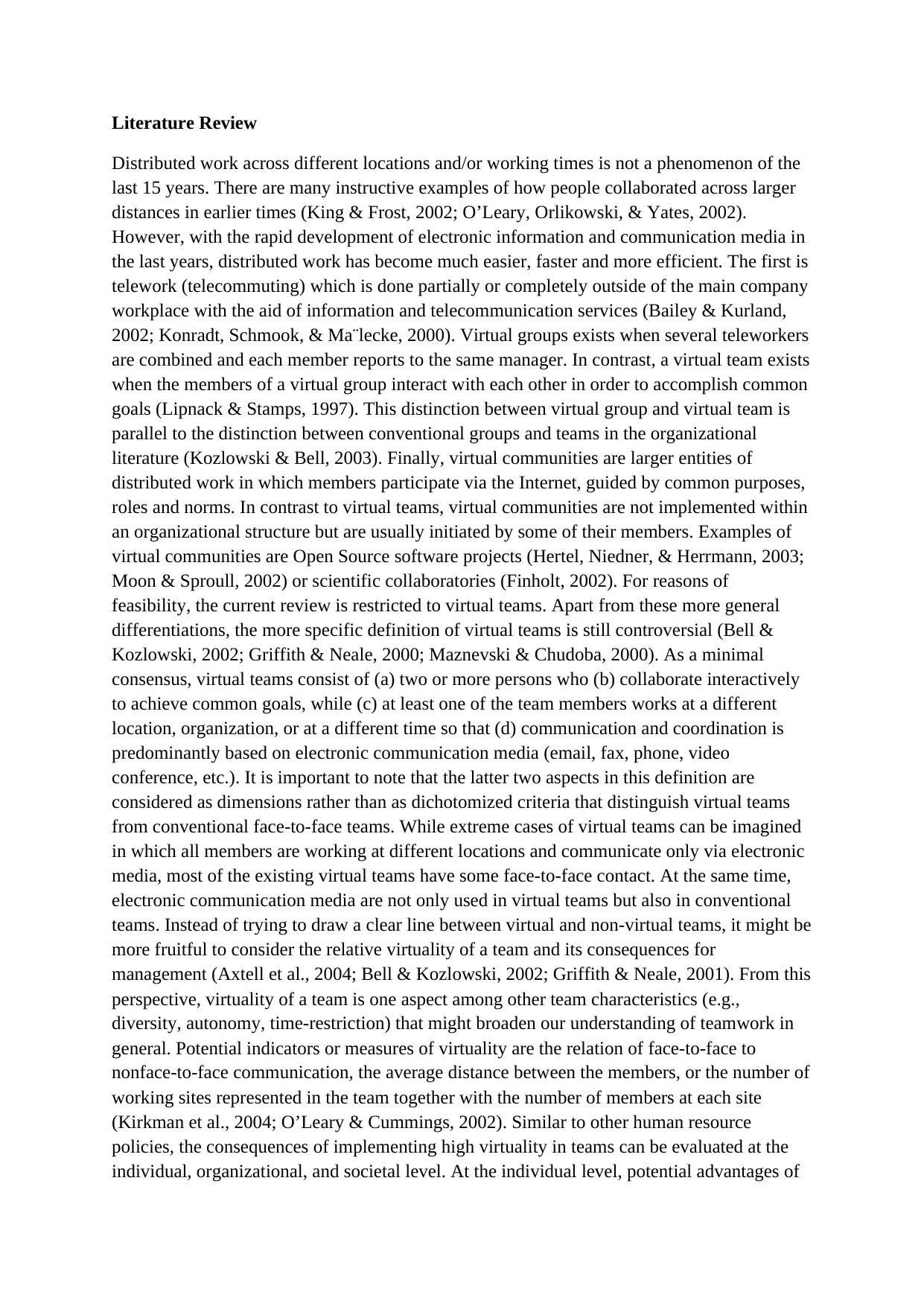
Literature Review
Distributed work across different locations and/or working times is not a phenomenon of the
last 15 years. There are many instructive examples of how people collaborated across larger
distances in earlier times (King & Frost, 2002; O’Leary, Orlikowski, & Yates, 2002).
However, with the rapid development of electronic information and communication media in
the last years, distributed work has become much easier, faster and more efficient. The first is
telework (telecommuting) which is done partially or completely outside of the main company
workplace with the aid of information and telecommunication services (Bailey & Kurland,
2002; Konradt, Schmook, & Ma¨lecke, 2000). Virtual groups exists when several teleworkers
are combined and each member reports to the same manager. In contrast, a virtual team exists
when the members of a virtual group interact with each other in order to accomplish common
goals (Lipnack & Stamps, 1997). This distinction between virtual group and virtual team is
parallel to the distinction between conventional groups and teams in the organizational
literature (Kozlowski & Bell, 2003). Finally, virtual communities are larger entities of
distributed work in which members participate via the Internet, guided by common purposes,
roles and norms. In contrast to virtual teams, virtual communities are not implemented within
an organizational structure but are usually initiated by some of their members. Examples of
virtual communities are Open Source software projects (Hertel, Niedner, & Herrmann, 2003;
Moon & Sproull, 2002) or scientific collaboratories (Finholt, 2002). For reasons of
feasibility, the current review is restricted to virtual teams. Apart from these more general
differentiations, the more specific definition of virtual teams is still controversial (Bell &
Kozlowski, 2002; Griffith & Neale, 2000; Maznevski & Chudoba, 2000). As a minimal
consensus, virtual teams consist of (a) two or more persons who (b) collaborate interactively
to achieve common goals, while (c) at least one of the team members works at a different
location, organization, or at a different time so that (d) communication and coordination is
predominantly based on electronic communication media (email, fax, phone, video
conference, etc.). It is important to note that the latter two aspects in this definition are
considered as dimensions rather than as dichotomized criteria that distinguish virtual teams
from conventional face-to-face teams. While extreme cases of virtual teams can be imagined
in which all members are working at different locations and communicate only via electronic
media, most of the existing virtual teams have some face-to-face contact. At the same time,
electronic communication media are not only used in virtual teams but also in conventional
teams. Instead of trying to draw a clear line between virtual and non-virtual teams, it might be
more fruitful to consider the relative virtuality of a team and its consequences for
management (Axtell et al., 2004; Bell & Kozlowski, 2002; Griffith & Neale, 2001). From this
perspective, virtuality of a team is one aspect among other team characteristics (e.g.,
diversity, autonomy, time-restriction) that might broaden our understanding of teamwork in
general. Potential indicators or measures of virtuality are the relation of face-to-face to
nonface-to-face communication, the average distance between the members, or the number of
working sites represented in the team together with the number of members at each site
(Kirkman et al., 2004; O’Leary & Cummings, 2002). Similar to other human resource
policies, the consequences of implementing high virtuality in teams can be evaluated at the
individual, organizational, and societal level. At the individual level, potential advantages of
Distributed work across different locations and/or working times is not a phenomenon of the
last 15 years. There are many instructive examples of how people collaborated across larger
distances in earlier times (King & Frost, 2002; O’Leary, Orlikowski, & Yates, 2002).
However, with the rapid development of electronic information and communication media in
the last years, distributed work has become much easier, faster and more efficient. The first is
telework (telecommuting) which is done partially or completely outside of the main company
workplace with the aid of information and telecommunication services (Bailey & Kurland,
2002; Konradt, Schmook, & Ma¨lecke, 2000). Virtual groups exists when several teleworkers
are combined and each member reports to the same manager. In contrast, a virtual team exists
when the members of a virtual group interact with each other in order to accomplish common
goals (Lipnack & Stamps, 1997). This distinction between virtual group and virtual team is
parallel to the distinction between conventional groups and teams in the organizational
literature (Kozlowski & Bell, 2003). Finally, virtual communities are larger entities of
distributed work in which members participate via the Internet, guided by common purposes,
roles and norms. In contrast to virtual teams, virtual communities are not implemented within
an organizational structure but are usually initiated by some of their members. Examples of
virtual communities are Open Source software projects (Hertel, Niedner, & Herrmann, 2003;
Moon & Sproull, 2002) or scientific collaboratories (Finholt, 2002). For reasons of
feasibility, the current review is restricted to virtual teams. Apart from these more general
differentiations, the more specific definition of virtual teams is still controversial (Bell &
Kozlowski, 2002; Griffith & Neale, 2000; Maznevski & Chudoba, 2000). As a minimal
consensus, virtual teams consist of (a) two or more persons who (b) collaborate interactively
to achieve common goals, while (c) at least one of the team members works at a different
location, organization, or at a different time so that (d) communication and coordination is
predominantly based on electronic communication media (email, fax, phone, video
conference, etc.). It is important to note that the latter two aspects in this definition are
considered as dimensions rather than as dichotomized criteria that distinguish virtual teams
from conventional face-to-face teams. While extreme cases of virtual teams can be imagined
in which all members are working at different locations and communicate only via electronic
media, most of the existing virtual teams have some face-to-face contact. At the same time,
electronic communication media are not only used in virtual teams but also in conventional
teams. Instead of trying to draw a clear line between virtual and non-virtual teams, it might be
more fruitful to consider the relative virtuality of a team and its consequences for
management (Axtell et al., 2004; Bell & Kozlowski, 2002; Griffith & Neale, 2001). From this
perspective, virtuality of a team is one aspect among other team characteristics (e.g.,
diversity, autonomy, time-restriction) that might broaden our understanding of teamwork in
general. Potential indicators or measures of virtuality are the relation of face-to-face to
nonface-to-face communication, the average distance between the members, or the number of
working sites represented in the team together with the number of members at each site
(Kirkman et al., 2004; O’Leary & Cummings, 2002). Similar to other human resource
policies, the consequences of implementing high virtuality in teams can be evaluated at the
individual, organizational, and societal level. At the individual level, potential advantages of
Paraphrase This Document
Need a fresh take? Get an instant paraphrase of this document with our AI Paraphraser
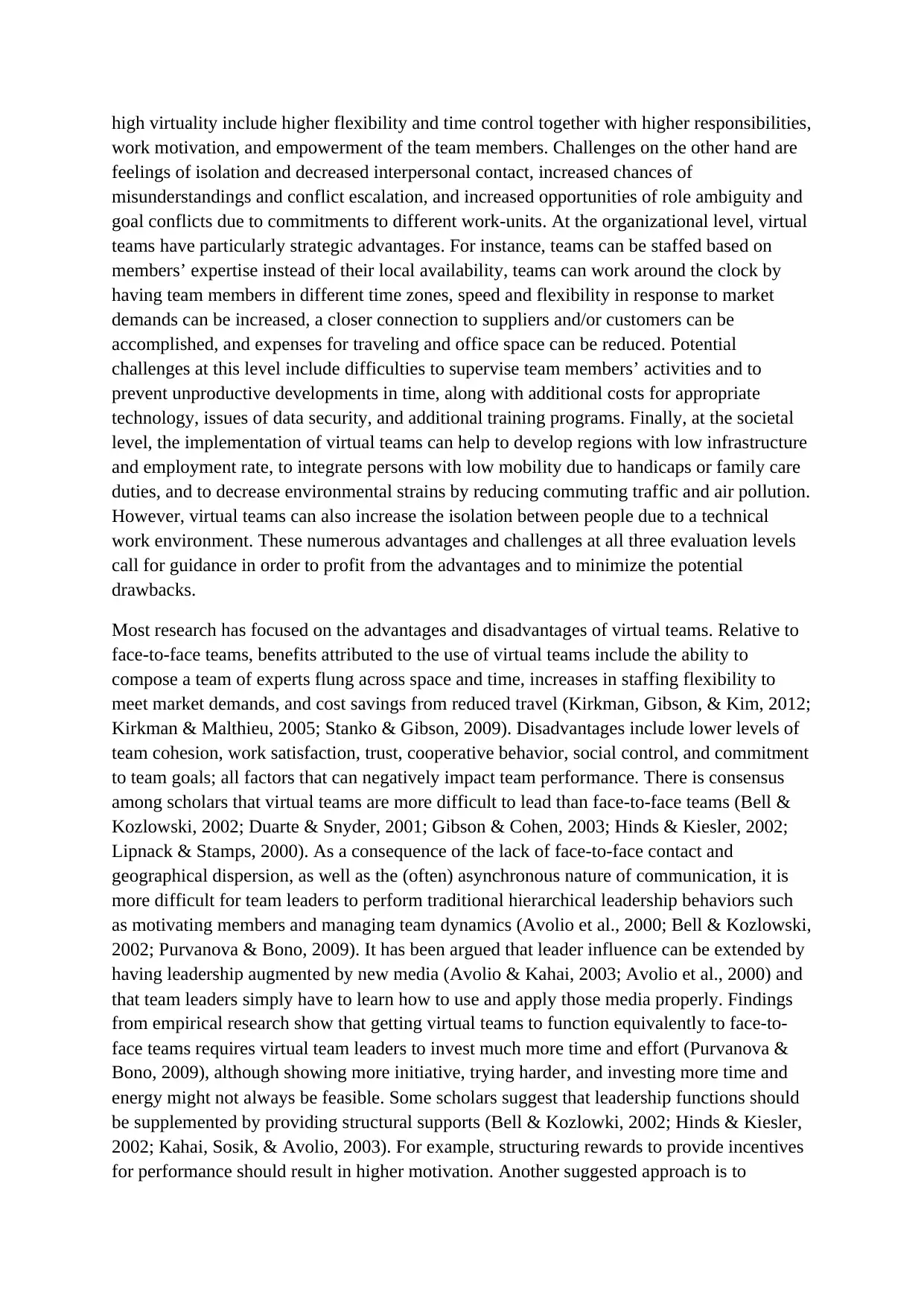
high virtuality include higher flexibility and time control together with higher responsibilities,
work motivation, and empowerment of the team members. Challenges on the other hand are
feelings of isolation and decreased interpersonal contact, increased chances of
misunderstandings and conflict escalation, and increased opportunities of role ambiguity and
goal conflicts due to commitments to different work-units. At the organizational level, virtual
teams have particularly strategic advantages. For instance, teams can be staffed based on
members’ expertise instead of their local availability, teams can work around the clock by
having team members in different time zones, speed and flexibility in response to market
demands can be increased, a closer connection to suppliers and/or customers can be
accomplished, and expenses for traveling and office space can be reduced. Potential
challenges at this level include difficulties to supervise team members’ activities and to
prevent unproductive developments in time, along with additional costs for appropriate
technology, issues of data security, and additional training programs. Finally, at the societal
level, the implementation of virtual teams can help to develop regions with low infrastructure
and employment rate, to integrate persons with low mobility due to handicaps or family care
duties, and to decrease environmental strains by reducing commuting traffic and air pollution.
However, virtual teams can also increase the isolation between people due to a technical
work environment. These numerous advantages and challenges at all three evaluation levels
call for guidance in order to profit from the advantages and to minimize the potential
drawbacks.
Most research has focused on the advantages and disadvantages of virtual teams. Relative to
face-to-face teams, benefits attributed to the use of virtual teams include the ability to
compose a team of experts flung across space and time, increases in staffing flexibility to
meet market demands, and cost savings from reduced travel (Kirkman, Gibson, & Kim, 2012;
Kirkman & Malthieu, 2005; Stanko & Gibson, 2009). Disadvantages include lower levels of
team cohesion, work satisfaction, trust, cooperative behavior, social control, and commitment
to team goals; all factors that can negatively impact team performance. There is consensus
among scholars that virtual teams are more difficult to lead than face-to-face teams (Bell &
Kozlowski, 2002; Duarte & Snyder, 2001; Gibson & Cohen, 2003; Hinds & Kiesler, 2002;
Lipnack & Stamps, 2000). As a consequence of the lack of face-to-face contact and
geographical dispersion, as well as the (often) asynchronous nature of communication, it is
more difficult for team leaders to perform traditional hierarchical leadership behaviors such
as motivating members and managing team dynamics (Avolio et al., 2000; Bell & Kozlowski,
2002; Purvanova & Bono, 2009). It has been argued that leader influence can be extended by
having leadership augmented by new media (Avolio & Kahai, 2003; Avolio et al., 2000) and
that team leaders simply have to learn how to use and apply those media properly. Findings
from empirical research show that getting virtual teams to function equivalently to face-to-
face teams requires virtual team leaders to invest much more time and effort (Purvanova &
Bono, 2009), although showing more initiative, trying harder, and investing more time and
energy might not always be feasible. Some scholars suggest that leadership functions should
be supplemented by providing structural supports (Bell & Kozlowki, 2002; Hinds & Kiesler,
2002; Kahai, Sosik, & Avolio, 2003). For example, structuring rewards to provide incentives
for performance should result in higher motivation. Another suggested approach is to
work motivation, and empowerment of the team members. Challenges on the other hand are
feelings of isolation and decreased interpersonal contact, increased chances of
misunderstandings and conflict escalation, and increased opportunities of role ambiguity and
goal conflicts due to commitments to different work-units. At the organizational level, virtual
teams have particularly strategic advantages. For instance, teams can be staffed based on
members’ expertise instead of their local availability, teams can work around the clock by
having team members in different time zones, speed and flexibility in response to market
demands can be increased, a closer connection to suppliers and/or customers can be
accomplished, and expenses for traveling and office space can be reduced. Potential
challenges at this level include difficulties to supervise team members’ activities and to
prevent unproductive developments in time, along with additional costs for appropriate
technology, issues of data security, and additional training programs. Finally, at the societal
level, the implementation of virtual teams can help to develop regions with low infrastructure
and employment rate, to integrate persons with low mobility due to handicaps or family care
duties, and to decrease environmental strains by reducing commuting traffic and air pollution.
However, virtual teams can also increase the isolation between people due to a technical
work environment. These numerous advantages and challenges at all three evaluation levels
call for guidance in order to profit from the advantages and to minimize the potential
drawbacks.
Most research has focused on the advantages and disadvantages of virtual teams. Relative to
face-to-face teams, benefits attributed to the use of virtual teams include the ability to
compose a team of experts flung across space and time, increases in staffing flexibility to
meet market demands, and cost savings from reduced travel (Kirkman, Gibson, & Kim, 2012;
Kirkman & Malthieu, 2005; Stanko & Gibson, 2009). Disadvantages include lower levels of
team cohesion, work satisfaction, trust, cooperative behavior, social control, and commitment
to team goals; all factors that can negatively impact team performance. There is consensus
among scholars that virtual teams are more difficult to lead than face-to-face teams (Bell &
Kozlowski, 2002; Duarte & Snyder, 2001; Gibson & Cohen, 2003; Hinds & Kiesler, 2002;
Lipnack & Stamps, 2000). As a consequence of the lack of face-to-face contact and
geographical dispersion, as well as the (often) asynchronous nature of communication, it is
more difficult for team leaders to perform traditional hierarchical leadership behaviors such
as motivating members and managing team dynamics (Avolio et al., 2000; Bell & Kozlowski,
2002; Purvanova & Bono, 2009). It has been argued that leader influence can be extended by
having leadership augmented by new media (Avolio & Kahai, 2003; Avolio et al., 2000) and
that team leaders simply have to learn how to use and apply those media properly. Findings
from empirical research show that getting virtual teams to function equivalently to face-to-
face teams requires virtual team leaders to invest much more time and effort (Purvanova &
Bono, 2009), although showing more initiative, trying harder, and investing more time and
energy might not always be feasible. Some scholars suggest that leadership functions should
be supplemented by providing structural supports (Bell & Kozlowki, 2002; Hinds & Kiesler,
2002; Kahai, Sosik, & Avolio, 2003). For example, structuring rewards to provide incentives
for performance should result in higher motivation. Another suggested approach is to
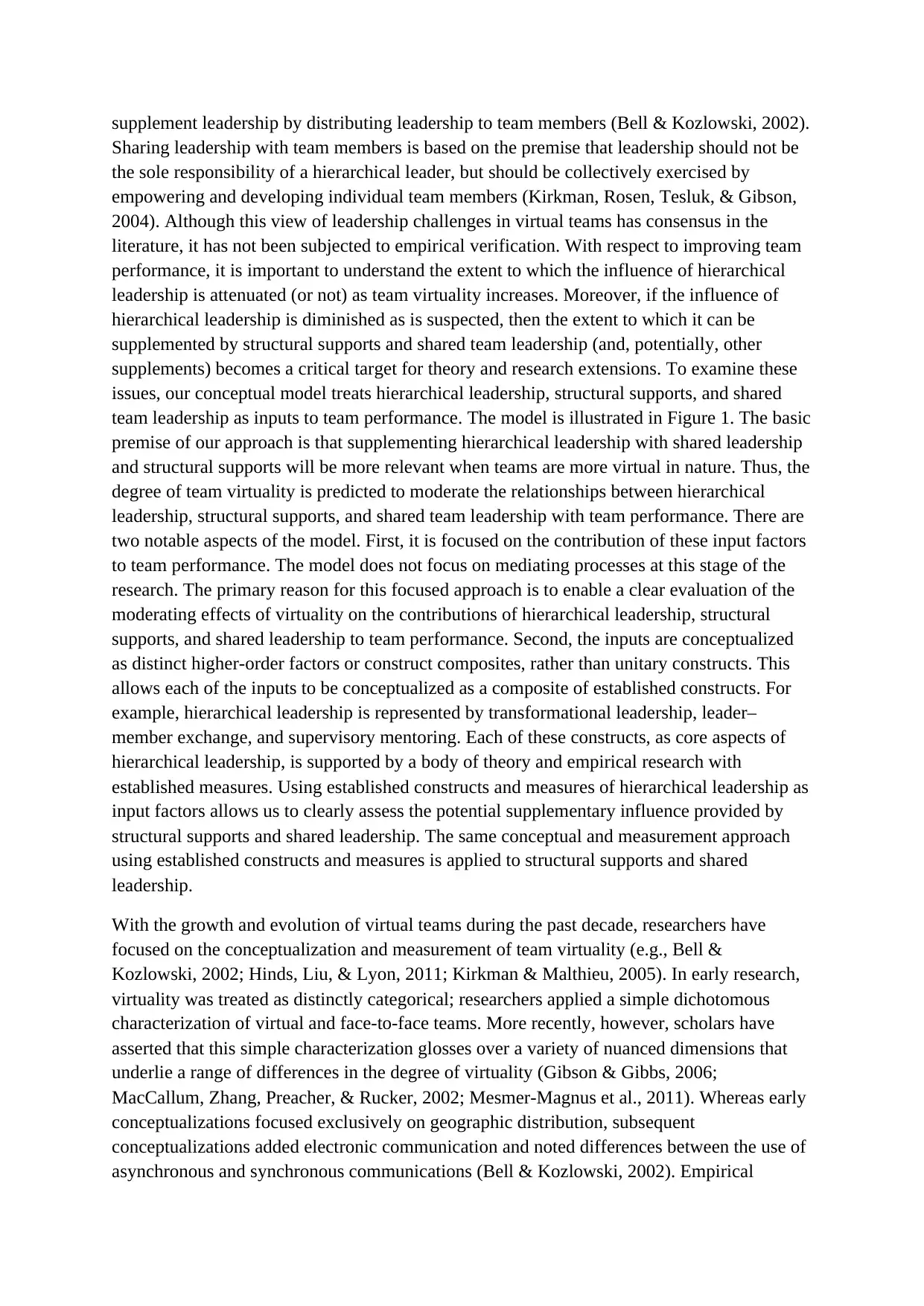
supplement leadership by distributing leadership to team members (Bell & Kozlowski, 2002).
Sharing leadership with team members is based on the premise that leadership should not be
the sole responsibility of a hierarchical leader, but should be collectively exercised by
empowering and developing individual team members (Kirkman, Rosen, Tesluk, & Gibson,
2004). Although this view of leadership challenges in virtual teams has consensus in the
literature, it has not been subjected to empirical verification. With respect to improving team
performance, it is important to understand the extent to which the influence of hierarchical
leadership is attenuated (or not) as team virtuality increases. Moreover, if the influence of
hierarchical leadership is diminished as is suspected, then the extent to which it can be
supplemented by structural supports and shared team leadership (and, potentially, other
supplements) becomes a critical target for theory and research extensions. To examine these
issues, our conceptual model treats hierarchical leadership, structural supports, and shared
team leadership as inputs to team performance. The model is illustrated in Figure 1. The basic
premise of our approach is that supplementing hierarchical leadership with shared leadership
and structural supports will be more relevant when teams are more virtual in nature. Thus, the
degree of team virtuality is predicted to moderate the relationships between hierarchical
leadership, structural supports, and shared team leadership with team performance. There are
two notable aspects of the model. First, it is focused on the contribution of these input factors
to team performance. The model does not focus on mediating processes at this stage of the
research. The primary reason for this focused approach is to enable a clear evaluation of the
moderating effects of virtuality on the contributions of hierarchical leadership, structural
supports, and shared leadership to team performance. Second, the inputs are conceptualized
as distinct higher-order factors or construct composites, rather than unitary constructs. This
allows each of the inputs to be conceptualized as a composite of established constructs. For
example, hierarchical leadership is represented by transformational leadership, leader–
member exchange, and supervisory mentoring. Each of these constructs, as core aspects of
hierarchical leadership, is supported by a body of theory and empirical research with
established measures. Using established constructs and measures of hierarchical leadership as
input factors allows us to clearly assess the potential supplementary influence provided by
structural supports and shared leadership. The same conceptual and measurement approach
using established constructs and measures is applied to structural supports and shared
leadership.
With the growth and evolution of virtual teams during the past decade, researchers have
focused on the conceptualization and measurement of team virtuality (e.g., Bell &
Kozlowski, 2002; Hinds, Liu, & Lyon, 2011; Kirkman & Malthieu, 2005). In early research,
virtuality was treated as distinctly categorical; researchers applied a simple dichotomous
characterization of virtual and face-to-face teams. More recently, however, scholars have
asserted that this simple characterization glosses over a variety of nuanced dimensions that
underlie a range of differences in the degree of virtuality (Gibson & Gibbs, 2006;
MacCallum, Zhang, Preacher, & Rucker, 2002; Mesmer-Magnus et al., 2011). Whereas early
conceptualizations focused exclusively on geographic distribution, subsequent
conceptualizations added electronic communication and noted differences between the use of
asynchronous and synchronous communications (Bell & Kozlowski, 2002). Empirical
Sharing leadership with team members is based on the premise that leadership should not be
the sole responsibility of a hierarchical leader, but should be collectively exercised by
empowering and developing individual team members (Kirkman, Rosen, Tesluk, & Gibson,
2004). Although this view of leadership challenges in virtual teams has consensus in the
literature, it has not been subjected to empirical verification. With respect to improving team
performance, it is important to understand the extent to which the influence of hierarchical
leadership is attenuated (or not) as team virtuality increases. Moreover, if the influence of
hierarchical leadership is diminished as is suspected, then the extent to which it can be
supplemented by structural supports and shared team leadership (and, potentially, other
supplements) becomes a critical target for theory and research extensions. To examine these
issues, our conceptual model treats hierarchical leadership, structural supports, and shared
team leadership as inputs to team performance. The model is illustrated in Figure 1. The basic
premise of our approach is that supplementing hierarchical leadership with shared leadership
and structural supports will be more relevant when teams are more virtual in nature. Thus, the
degree of team virtuality is predicted to moderate the relationships between hierarchical
leadership, structural supports, and shared team leadership with team performance. There are
two notable aspects of the model. First, it is focused on the contribution of these input factors
to team performance. The model does not focus on mediating processes at this stage of the
research. The primary reason for this focused approach is to enable a clear evaluation of the
moderating effects of virtuality on the contributions of hierarchical leadership, structural
supports, and shared leadership to team performance. Second, the inputs are conceptualized
as distinct higher-order factors or construct composites, rather than unitary constructs. This
allows each of the inputs to be conceptualized as a composite of established constructs. For
example, hierarchical leadership is represented by transformational leadership, leader–
member exchange, and supervisory mentoring. Each of these constructs, as core aspects of
hierarchical leadership, is supported by a body of theory and empirical research with
established measures. Using established constructs and measures of hierarchical leadership as
input factors allows us to clearly assess the potential supplementary influence provided by
structural supports and shared leadership. The same conceptual and measurement approach
using established constructs and measures is applied to structural supports and shared
leadership.
With the growth and evolution of virtual teams during the past decade, researchers have
focused on the conceptualization and measurement of team virtuality (e.g., Bell &
Kozlowski, 2002; Hinds, Liu, & Lyon, 2011; Kirkman & Malthieu, 2005). In early research,
virtuality was treated as distinctly categorical; researchers applied a simple dichotomous
characterization of virtual and face-to-face teams. More recently, however, scholars have
asserted that this simple characterization glosses over a variety of nuanced dimensions that
underlie a range of differences in the degree of virtuality (Gibson & Gibbs, 2006;
MacCallum, Zhang, Preacher, & Rucker, 2002; Mesmer-Magnus et al., 2011). Whereas early
conceptualizations focused exclusively on geographic distribution, subsequent
conceptualizations added electronic communication and noted differences between the use of
asynchronous and synchronous communications (Bell & Kozlowski, 2002). Empirical
⊘ This is a preview!⊘
Do you want full access?
Subscribe today to unlock all pages.

Trusted by 1+ million students worldwide
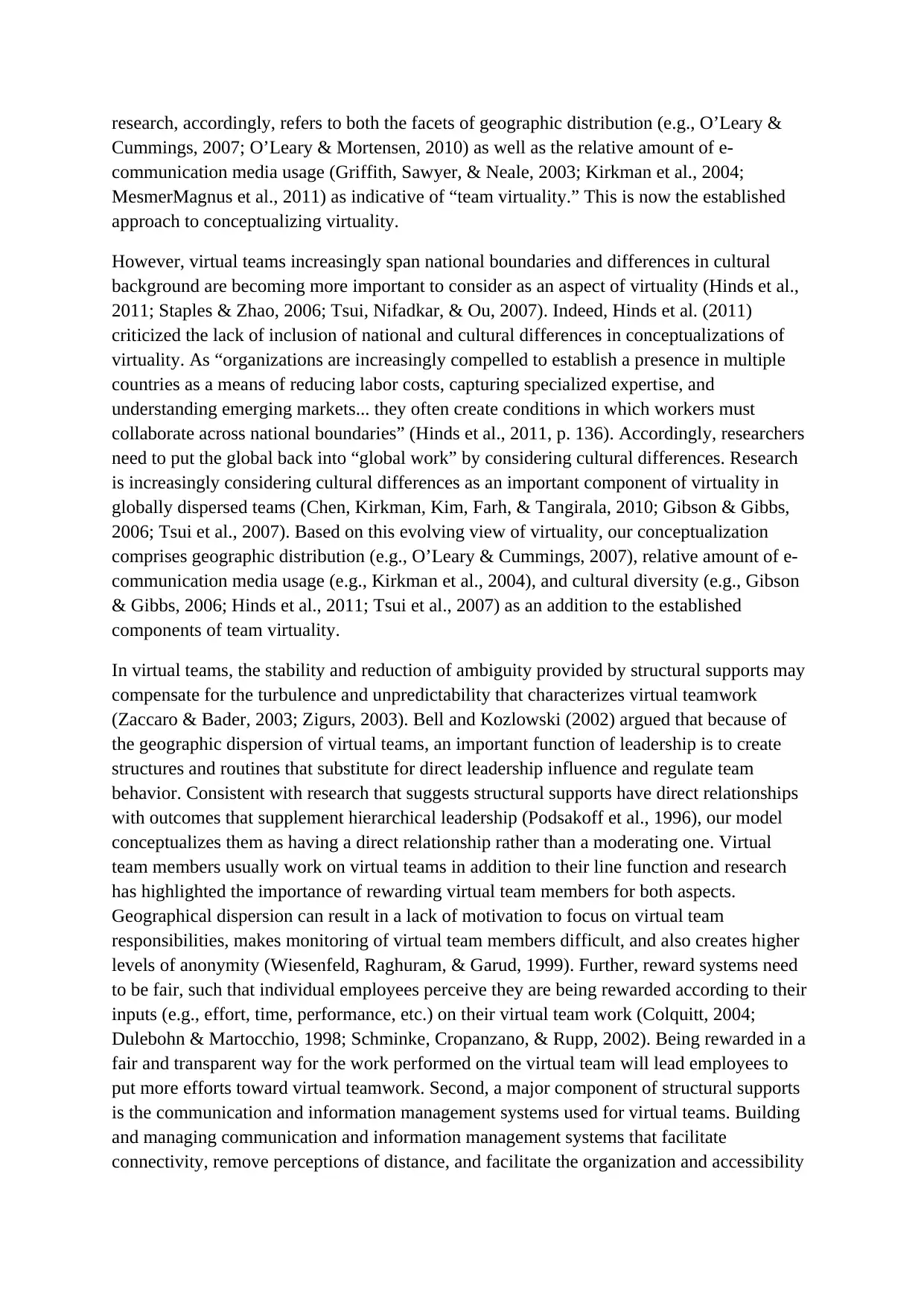
research, accordingly, refers to both the facets of geographic distribution (e.g., O’Leary &
Cummings, 2007; O’Leary & Mortensen, 2010) as well as the relative amount of e-
communication media usage (Griffith, Sawyer, & Neale, 2003; Kirkman et al., 2004;
MesmerMagnus et al., 2011) as indicative of “team virtuality.” This is now the established
approach to conceptualizing virtuality.
However, virtual teams increasingly span national boundaries and differences in cultural
background are becoming more important to consider as an aspect of virtuality (Hinds et al.,
2011; Staples & Zhao, 2006; Tsui, Nifadkar, & Ou, 2007). Indeed, Hinds et al. (2011)
criticized the lack of inclusion of national and cultural differences in conceptualizations of
virtuality. As “organizations are increasingly compelled to establish a presence in multiple
countries as a means of reducing labor costs, capturing specialized expertise, and
understanding emerging markets... they often create conditions in which workers must
collaborate across national boundaries” (Hinds et al., 2011, p. 136). Accordingly, researchers
need to put the global back into “global work” by considering cultural differences. Research
is increasingly considering cultural differences as an important component of virtuality in
globally dispersed teams (Chen, Kirkman, Kim, Farh, & Tangirala, 2010; Gibson & Gibbs,
2006; Tsui et al., 2007). Based on this evolving view of virtuality, our conceptualization
comprises geographic distribution (e.g., O’Leary & Cummings, 2007), relative amount of e-
communication media usage (e.g., Kirkman et al., 2004), and cultural diversity (e.g., Gibson
& Gibbs, 2006; Hinds et al., 2011; Tsui et al., 2007) as an addition to the established
components of team virtuality.
In virtual teams, the stability and reduction of ambiguity provided by structural supports may
compensate for the turbulence and unpredictability that characterizes virtual teamwork
(Zaccaro & Bader, 2003; Zigurs, 2003). Bell and Kozlowski (2002) argued that because of
the geographic dispersion of virtual teams, an important function of leadership is to create
structures and routines that substitute for direct leadership influence and regulate team
behavior. Consistent with research that suggests structural supports have direct relationships
with outcomes that supplement hierarchical leadership (Podsakoff et al., 1996), our model
conceptualizes them as having a direct relationship rather than a moderating one. Virtual
team members usually work on virtual teams in addition to their line function and research
has highlighted the importance of rewarding virtual team members for both aspects.
Geographical dispersion can result in a lack of motivation to focus on virtual team
responsibilities, makes monitoring of virtual team members difficult, and also creates higher
levels of anonymity (Wiesenfeld, Raghuram, & Garud, 1999). Further, reward systems need
to be fair, such that individual employees perceive they are being rewarded according to their
inputs (e.g., effort, time, performance, etc.) on their virtual team work (Colquitt, 2004;
Dulebohn & Martocchio, 1998; Schminke, Cropanzano, & Rupp, 2002). Being rewarded in a
fair and transparent way for the work performed on the virtual team will lead employees to
put more efforts toward virtual teamwork. Second, a major component of structural supports
is the communication and information management systems used for virtual teams. Building
and managing communication and information management systems that facilitate
connectivity, remove perceptions of distance, and facilitate the organization and accessibility
Cummings, 2007; O’Leary & Mortensen, 2010) as well as the relative amount of e-
communication media usage (Griffith, Sawyer, & Neale, 2003; Kirkman et al., 2004;
MesmerMagnus et al., 2011) as indicative of “team virtuality.” This is now the established
approach to conceptualizing virtuality.
However, virtual teams increasingly span national boundaries and differences in cultural
background are becoming more important to consider as an aspect of virtuality (Hinds et al.,
2011; Staples & Zhao, 2006; Tsui, Nifadkar, & Ou, 2007). Indeed, Hinds et al. (2011)
criticized the lack of inclusion of national and cultural differences in conceptualizations of
virtuality. As “organizations are increasingly compelled to establish a presence in multiple
countries as a means of reducing labor costs, capturing specialized expertise, and
understanding emerging markets... they often create conditions in which workers must
collaborate across national boundaries” (Hinds et al., 2011, p. 136). Accordingly, researchers
need to put the global back into “global work” by considering cultural differences. Research
is increasingly considering cultural differences as an important component of virtuality in
globally dispersed teams (Chen, Kirkman, Kim, Farh, & Tangirala, 2010; Gibson & Gibbs,
2006; Tsui et al., 2007). Based on this evolving view of virtuality, our conceptualization
comprises geographic distribution (e.g., O’Leary & Cummings, 2007), relative amount of e-
communication media usage (e.g., Kirkman et al., 2004), and cultural diversity (e.g., Gibson
& Gibbs, 2006; Hinds et al., 2011; Tsui et al., 2007) as an addition to the established
components of team virtuality.
In virtual teams, the stability and reduction of ambiguity provided by structural supports may
compensate for the turbulence and unpredictability that characterizes virtual teamwork
(Zaccaro & Bader, 2003; Zigurs, 2003). Bell and Kozlowski (2002) argued that because of
the geographic dispersion of virtual teams, an important function of leadership is to create
structures and routines that substitute for direct leadership influence and regulate team
behavior. Consistent with research that suggests structural supports have direct relationships
with outcomes that supplement hierarchical leadership (Podsakoff et al., 1996), our model
conceptualizes them as having a direct relationship rather than a moderating one. Virtual
team members usually work on virtual teams in addition to their line function and research
has highlighted the importance of rewarding virtual team members for both aspects.
Geographical dispersion can result in a lack of motivation to focus on virtual team
responsibilities, makes monitoring of virtual team members difficult, and also creates higher
levels of anonymity (Wiesenfeld, Raghuram, & Garud, 1999). Further, reward systems need
to be fair, such that individual employees perceive they are being rewarded according to their
inputs (e.g., effort, time, performance, etc.) on their virtual team work (Colquitt, 2004;
Dulebohn & Martocchio, 1998; Schminke, Cropanzano, & Rupp, 2002). Being rewarded in a
fair and transparent way for the work performed on the virtual team will lead employees to
put more efforts toward virtual teamwork. Second, a major component of structural supports
is the communication and information management systems used for virtual teams. Building
and managing communication and information management systems that facilitate
connectivity, remove perceptions of distance, and facilitate the organization and accessibility
Paraphrase This Document
Need a fresh take? Get an instant paraphrase of this document with our AI Paraphraser
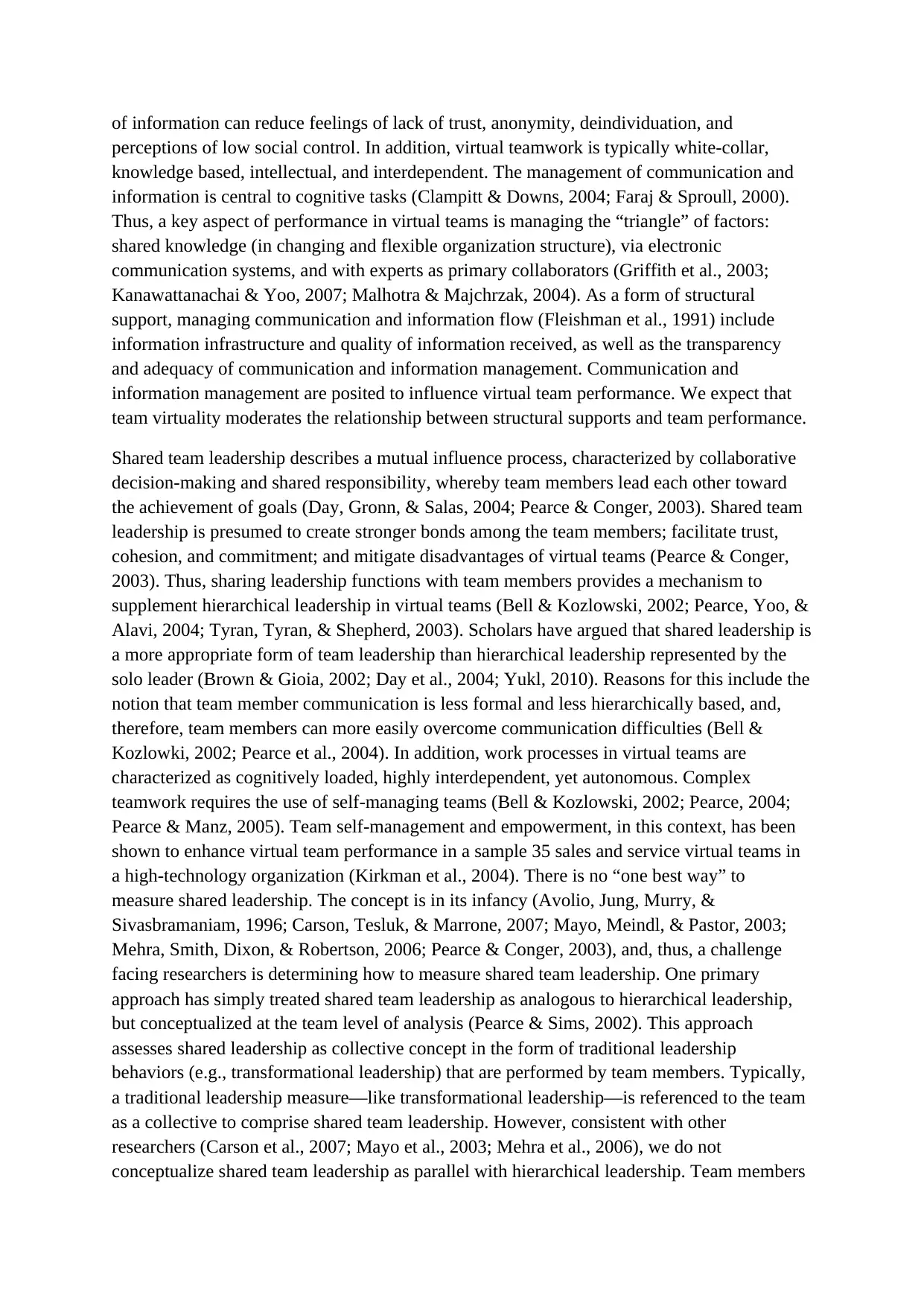
of information can reduce feelings of lack of trust, anonymity, deindividuation, and
perceptions of low social control. In addition, virtual teamwork is typically white-collar,
knowledge based, intellectual, and interdependent. The management of communication and
information is central to cognitive tasks (Clampitt & Downs, 2004; Faraj & Sproull, 2000).
Thus, a key aspect of performance in virtual teams is managing the “triangle” of factors:
shared knowledge (in changing and flexible organization structure), via electronic
communication systems, and with experts as primary collaborators (Griffith et al., 2003;
Kanawattanachai & Yoo, 2007; Malhotra & Majchrzak, 2004). As a form of structural
support, managing communication and information flow (Fleishman et al., 1991) include
information infrastructure and quality of information received, as well as the transparency
and adequacy of communication and information management. Communication and
information management are posited to influence virtual team performance. We expect that
team virtuality moderates the relationship between structural supports and team performance.
Shared team leadership describes a mutual influence process, characterized by collaborative
decision-making and shared responsibility, whereby team members lead each other toward
the achievement of goals (Day, Gronn, & Salas, 2004; Pearce & Conger, 2003). Shared team
leadership is presumed to create stronger bonds among the team members; facilitate trust,
cohesion, and commitment; and mitigate disadvantages of virtual teams (Pearce & Conger,
2003). Thus, sharing leadership functions with team members provides a mechanism to
supplement hierarchical leadership in virtual teams (Bell & Kozlowski, 2002; Pearce, Yoo, &
Alavi, 2004; Tyran, Tyran, & Shepherd, 2003). Scholars have argued that shared leadership is
a more appropriate form of team leadership than hierarchical leadership represented by the
solo leader (Brown & Gioia, 2002; Day et al., 2004; Yukl, 2010). Reasons for this include the
notion that team member communication is less formal and less hierarchically based, and,
therefore, team members can more easily overcome communication difficulties (Bell &
Kozlowki, 2002; Pearce et al., 2004). In addition, work processes in virtual teams are
characterized as cognitively loaded, highly interdependent, yet autonomous. Complex
teamwork requires the use of self-managing teams (Bell & Kozlowski, 2002; Pearce, 2004;
Pearce & Manz, 2005). Team self-management and empowerment, in this context, has been
shown to enhance virtual team performance in a sample 35 sales and service virtual teams in
a high-technology organization (Kirkman et al., 2004). There is no “one best way” to
measure shared leadership. The concept is in its infancy (Avolio, Jung, Murry, &
Sivasbramaniam, 1996; Carson, Tesluk, & Marrone, 2007; Mayo, Meindl, & Pastor, 2003;
Mehra, Smith, Dixon, & Robertson, 2006; Pearce & Conger, 2003), and, thus, a challenge
facing researchers is determining how to measure shared team leadership. One primary
approach has simply treated shared team leadership as analogous to hierarchical leadership,
but conceptualized at the team level of analysis (Pearce & Sims, 2002). This approach
assesses shared leadership as collective concept in the form of traditional leadership
behaviors (e.g., transformational leadership) that are performed by team members. Typically,
a traditional leadership measure—like transformational leadership—is referenced to the team
as a collective to comprise shared team leadership. However, consistent with other
researchers (Carson et al., 2007; Mayo et al., 2003; Mehra et al., 2006), we do not
conceptualize shared team leadership as parallel with hierarchical leadership. Team members
perceptions of low social control. In addition, virtual teamwork is typically white-collar,
knowledge based, intellectual, and interdependent. The management of communication and
information is central to cognitive tasks (Clampitt & Downs, 2004; Faraj & Sproull, 2000).
Thus, a key aspect of performance in virtual teams is managing the “triangle” of factors:
shared knowledge (in changing and flexible organization structure), via electronic
communication systems, and with experts as primary collaborators (Griffith et al., 2003;
Kanawattanachai & Yoo, 2007; Malhotra & Majchrzak, 2004). As a form of structural
support, managing communication and information flow (Fleishman et al., 1991) include
information infrastructure and quality of information received, as well as the transparency
and adequacy of communication and information management. Communication and
information management are posited to influence virtual team performance. We expect that
team virtuality moderates the relationship between structural supports and team performance.
Shared team leadership describes a mutual influence process, characterized by collaborative
decision-making and shared responsibility, whereby team members lead each other toward
the achievement of goals (Day, Gronn, & Salas, 2004; Pearce & Conger, 2003). Shared team
leadership is presumed to create stronger bonds among the team members; facilitate trust,
cohesion, and commitment; and mitigate disadvantages of virtual teams (Pearce & Conger,
2003). Thus, sharing leadership functions with team members provides a mechanism to
supplement hierarchical leadership in virtual teams (Bell & Kozlowski, 2002; Pearce, Yoo, &
Alavi, 2004; Tyran, Tyran, & Shepherd, 2003). Scholars have argued that shared leadership is
a more appropriate form of team leadership than hierarchical leadership represented by the
solo leader (Brown & Gioia, 2002; Day et al., 2004; Yukl, 2010). Reasons for this include the
notion that team member communication is less formal and less hierarchically based, and,
therefore, team members can more easily overcome communication difficulties (Bell &
Kozlowki, 2002; Pearce et al., 2004). In addition, work processes in virtual teams are
characterized as cognitively loaded, highly interdependent, yet autonomous. Complex
teamwork requires the use of self-managing teams (Bell & Kozlowski, 2002; Pearce, 2004;
Pearce & Manz, 2005). Team self-management and empowerment, in this context, has been
shown to enhance virtual team performance in a sample 35 sales and service virtual teams in
a high-technology organization (Kirkman et al., 2004). There is no “one best way” to
measure shared leadership. The concept is in its infancy (Avolio, Jung, Murry, &
Sivasbramaniam, 1996; Carson, Tesluk, & Marrone, 2007; Mayo, Meindl, & Pastor, 2003;
Mehra, Smith, Dixon, & Robertson, 2006; Pearce & Conger, 2003), and, thus, a challenge
facing researchers is determining how to measure shared team leadership. One primary
approach has simply treated shared team leadership as analogous to hierarchical leadership,
but conceptualized at the team level of analysis (Pearce & Sims, 2002). This approach
assesses shared leadership as collective concept in the form of traditional leadership
behaviors (e.g., transformational leadership) that are performed by team members. Typically,
a traditional leadership measure—like transformational leadership—is referenced to the team
as a collective to comprise shared team leadership. However, consistent with other
researchers (Carson et al., 2007; Mayo et al., 2003; Mehra et al., 2006), we do not
conceptualize shared team leadership as parallel with hierarchical leadership. Team members
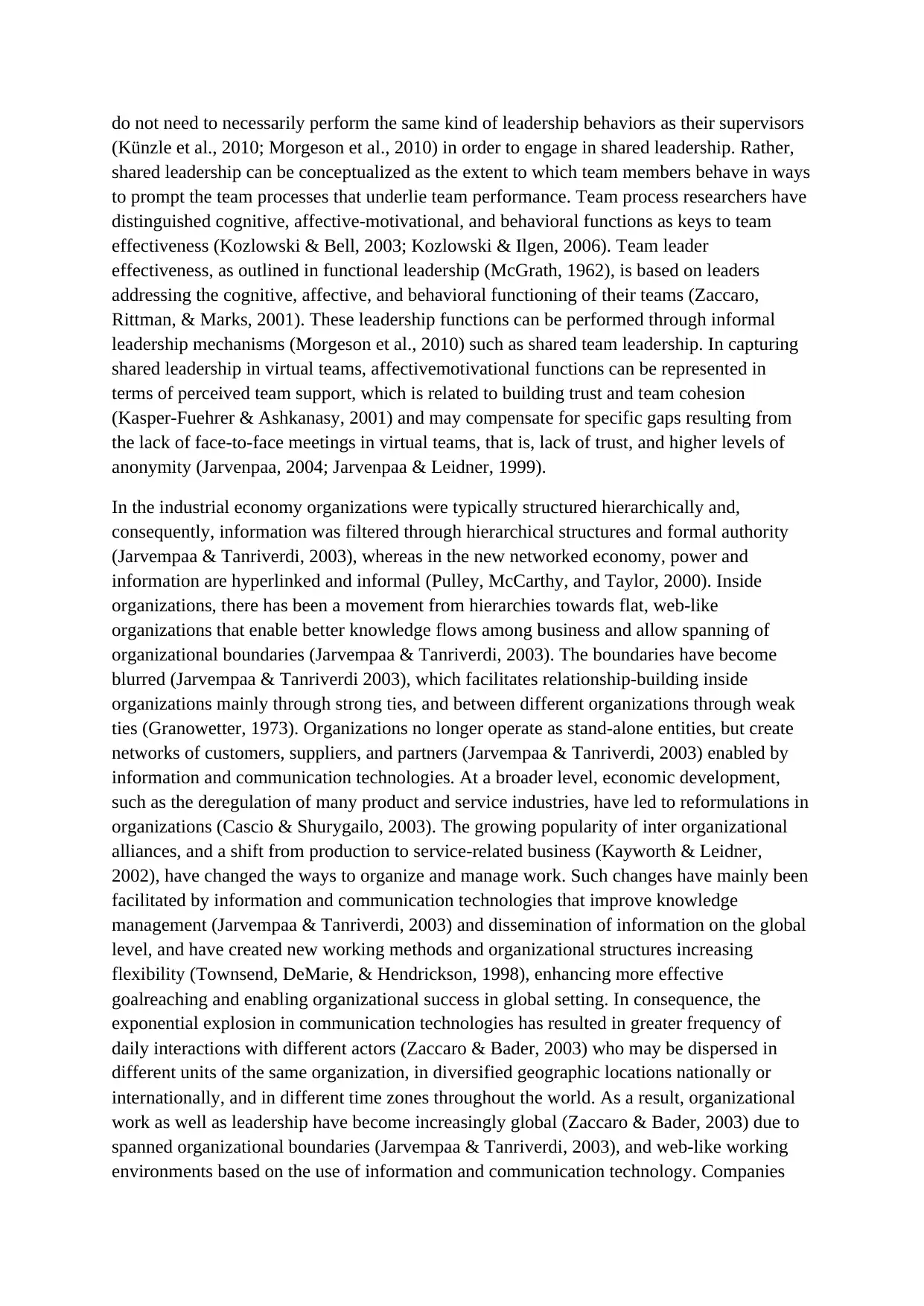
do not need to necessarily perform the same kind of leadership behaviors as their supervisors
(Künzle et al., 2010; Morgeson et al., 2010) in order to engage in shared leadership. Rather,
shared leadership can be conceptualized as the extent to which team members behave in ways
to prompt the team processes that underlie team performance. Team process researchers have
distinguished cognitive, affective-motivational, and behavioral functions as keys to team
effectiveness (Kozlowski & Bell, 2003; Kozlowski & Ilgen, 2006). Team leader
effectiveness, as outlined in functional leadership (McGrath, 1962), is based on leaders
addressing the cognitive, affective, and behavioral functioning of their teams (Zaccaro,
Rittman, & Marks, 2001). These leadership functions can be performed through informal
leadership mechanisms (Morgeson et al., 2010) such as shared team leadership. In capturing
shared leadership in virtual teams, affectivemotivational functions can be represented in
terms of perceived team support, which is related to building trust and team cohesion
(Kasper-Fuehrer & Ashkanasy, 2001) and may compensate for specific gaps resulting from
the lack of face-to-face meetings in virtual teams, that is, lack of trust, and higher levels of
anonymity (Jarvenpaa, 2004; Jarvenpaa & Leidner, 1999).
In the industrial economy organizations were typically structured hierarchically and,
consequently, information was filtered through hierarchical structures and formal authority
(Jarvempaa & Tanriverdi, 2003), whereas in the new networked economy, power and
information are hyperlinked and informal (Pulley, McCarthy, and Taylor, 2000). Inside
organizations, there has been a movement from hierarchies towards flat, web-like
organizations that enable better knowledge flows among business and allow spanning of
organizational boundaries (Jarvempaa & Tanriverdi, 2003). The boundaries have become
blurred (Jarvempaa & Tanriverdi 2003), which facilitates relationship-building inside
organizations mainly through strong ties, and between different organizations through weak
ties (Granowetter, 1973). Organizations no longer operate as stand-alone entities, but create
networks of customers, suppliers, and partners (Jarvempaa & Tanriverdi, 2003) enabled by
information and communication technologies. At a broader level, economic development,
such as the deregulation of many product and service industries, have led to reformulations in
organizations (Cascio & Shurygailo, 2003). The growing popularity of inter organizational
alliances, and a shift from production to service-related business (Kayworth & Leidner,
2002), have changed the ways to organize and manage work. Such changes have mainly been
facilitated by information and communication technologies that improve knowledge
management (Jarvempaa & Tanriverdi, 2003) and dissemination of information on the global
level, and have created new working methods and organizational structures increasing
flexibility (Townsend, DeMarie, & Hendrickson, 1998), enhancing more effective
goalreaching and enabling organizational success in global setting. In consequence, the
exponential explosion in communication technologies has resulted in greater frequency of
daily interactions with different actors (Zaccaro & Bader, 2003) who may be dispersed in
different units of the same organization, in diversified geographic locations nationally or
internationally, and in different time zones throughout the world. As a result, organizational
work as well as leadership have become increasingly global (Zaccaro & Bader, 2003) due to
spanned organizational boundaries (Jarvempaa & Tanriverdi, 2003), and web-like working
environments based on the use of information and communication technology. Companies
(Künzle et al., 2010; Morgeson et al., 2010) in order to engage in shared leadership. Rather,
shared leadership can be conceptualized as the extent to which team members behave in ways
to prompt the team processes that underlie team performance. Team process researchers have
distinguished cognitive, affective-motivational, and behavioral functions as keys to team
effectiveness (Kozlowski & Bell, 2003; Kozlowski & Ilgen, 2006). Team leader
effectiveness, as outlined in functional leadership (McGrath, 1962), is based on leaders
addressing the cognitive, affective, and behavioral functioning of their teams (Zaccaro,
Rittman, & Marks, 2001). These leadership functions can be performed through informal
leadership mechanisms (Morgeson et al., 2010) such as shared team leadership. In capturing
shared leadership in virtual teams, affectivemotivational functions can be represented in
terms of perceived team support, which is related to building trust and team cohesion
(Kasper-Fuehrer & Ashkanasy, 2001) and may compensate for specific gaps resulting from
the lack of face-to-face meetings in virtual teams, that is, lack of trust, and higher levels of
anonymity (Jarvenpaa, 2004; Jarvenpaa & Leidner, 1999).
In the industrial economy organizations were typically structured hierarchically and,
consequently, information was filtered through hierarchical structures and formal authority
(Jarvempaa & Tanriverdi, 2003), whereas in the new networked economy, power and
information are hyperlinked and informal (Pulley, McCarthy, and Taylor, 2000). Inside
organizations, there has been a movement from hierarchies towards flat, web-like
organizations that enable better knowledge flows among business and allow spanning of
organizational boundaries (Jarvempaa & Tanriverdi, 2003). The boundaries have become
blurred (Jarvempaa & Tanriverdi 2003), which facilitates relationship-building inside
organizations mainly through strong ties, and between different organizations through weak
ties (Granowetter, 1973). Organizations no longer operate as stand-alone entities, but create
networks of customers, suppliers, and partners (Jarvempaa & Tanriverdi, 2003) enabled by
information and communication technologies. At a broader level, economic development,
such as the deregulation of many product and service industries, have led to reformulations in
organizations (Cascio & Shurygailo, 2003). The growing popularity of inter organizational
alliances, and a shift from production to service-related business (Kayworth & Leidner,
2002), have changed the ways to organize and manage work. Such changes have mainly been
facilitated by information and communication technologies that improve knowledge
management (Jarvempaa & Tanriverdi, 2003) and dissemination of information on the global
level, and have created new working methods and organizational structures increasing
flexibility (Townsend, DeMarie, & Hendrickson, 1998), enhancing more effective
goalreaching and enabling organizational success in global setting. In consequence, the
exponential explosion in communication technologies has resulted in greater frequency of
daily interactions with different actors (Zaccaro & Bader, 2003) who may be dispersed in
different units of the same organization, in diversified geographic locations nationally or
internationally, and in different time zones throughout the world. As a result, organizational
work as well as leadership have become increasingly global (Zaccaro & Bader, 2003) due to
spanned organizational boundaries (Jarvempaa & Tanriverdi, 2003), and web-like working
environments based on the use of information and communication technology. Companies
⊘ This is a preview!⊘
Do you want full access?
Subscribe today to unlock all pages.

Trusted by 1+ million students worldwide
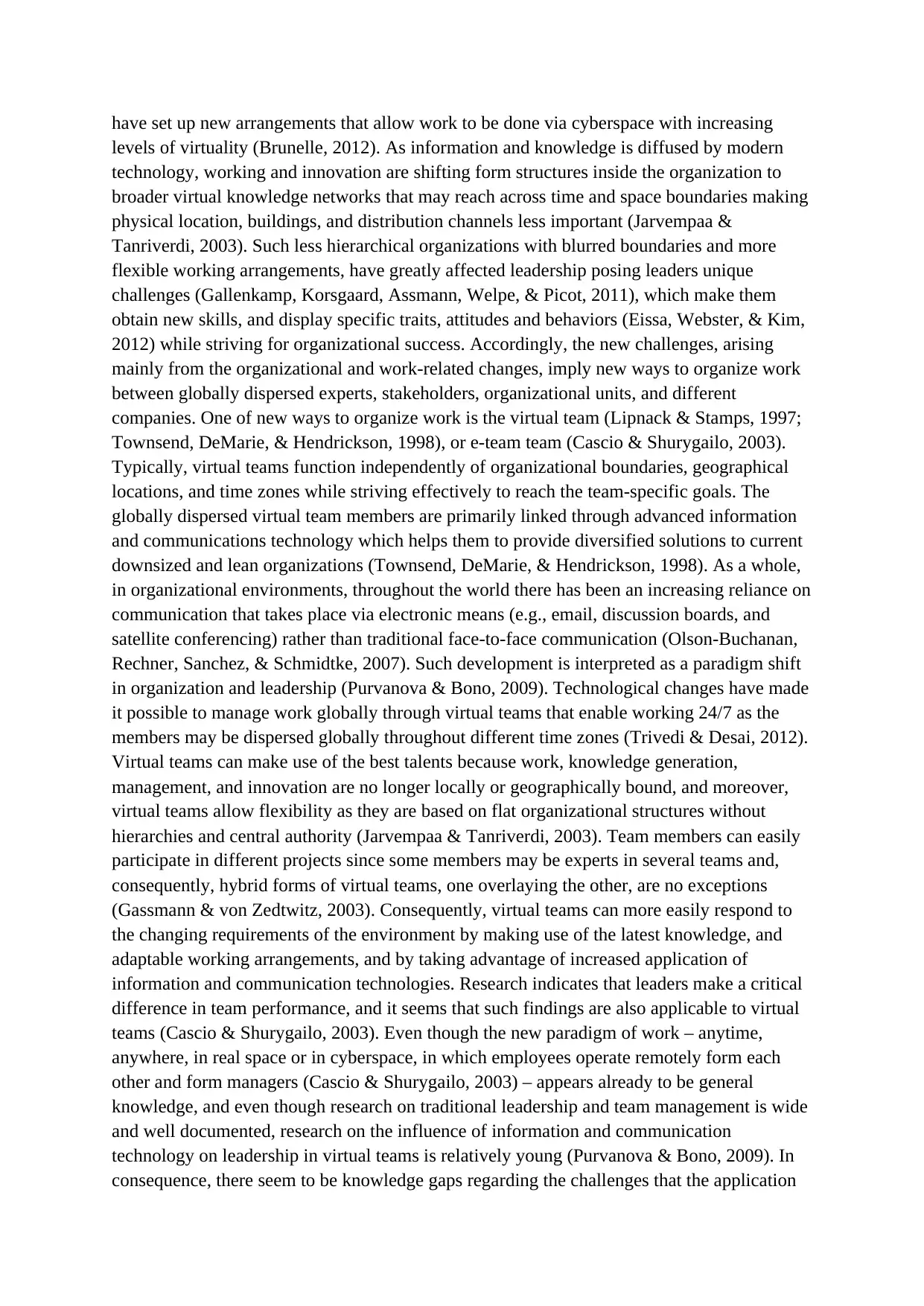
have set up new arrangements that allow work to be done via cyberspace with increasing
levels of virtuality (Brunelle, 2012). As information and knowledge is diffused by modern
technology, working and innovation are shifting form structures inside the organization to
broader virtual knowledge networks that may reach across time and space boundaries making
physical location, buildings, and distribution channels less important (Jarvempaa &
Tanriverdi, 2003). Such less hierarchical organizations with blurred boundaries and more
flexible working arrangements, have greatly affected leadership posing leaders unique
challenges (Gallenkamp, Korsgaard, Assmann, Welpe, & Picot, 2011), which make them
obtain new skills, and display specific traits, attitudes and behaviors (Eissa, Webster, & Kim,
2012) while striving for organizational success. Accordingly, the new challenges, arising
mainly from the organizational and work-related changes, imply new ways to organize work
between globally dispersed experts, stakeholders, organizational units, and different
companies. One of new ways to organize work is the virtual team (Lipnack & Stamps, 1997;
Townsend, DeMarie, & Hendrickson, 1998), or e-team team (Cascio & Shurygailo, 2003).
Typically, virtual teams function independently of organizational boundaries, geographical
locations, and time zones while striving effectively to reach the team-specific goals. The
globally dispersed virtual team members are primarily linked through advanced information
and communications technology which helps them to provide diversified solutions to current
downsized and lean organizations (Townsend, DeMarie, & Hendrickson, 1998). As a whole,
in organizational environments, throughout the world there has been an increasing reliance on
communication that takes place via electronic means (e.g., email, discussion boards, and
satellite conferencing) rather than traditional face-to-face communication (Olson-Buchanan,
Rechner, Sanchez, & Schmidtke, 2007). Such development is interpreted as a paradigm shift
in organization and leadership (Purvanova & Bono, 2009). Technological changes have made
it possible to manage work globally through virtual teams that enable working 24/7 as the
members may be dispersed globally throughout different time zones (Trivedi & Desai, 2012).
Virtual teams can make use of the best talents because work, knowledge generation,
management, and innovation are no longer locally or geographically bound, and moreover,
virtual teams allow flexibility as they are based on flat organizational structures without
hierarchies and central authority (Jarvempaa & Tanriverdi, 2003). Team members can easily
participate in different projects since some members may be experts in several teams and,
consequently, hybrid forms of virtual teams, one overlaying the other, are no exceptions
(Gassmann & von Zedtwitz, 2003). Consequently, virtual teams can more easily respond to
the changing requirements of the environment by making use of the latest knowledge, and
adaptable working arrangements, and by taking advantage of increased application of
information and communication technologies. Research indicates that leaders make a critical
difference in team performance, and it seems that such findings are also applicable to virtual
teams (Cascio & Shurygailo, 2003). Even though the new paradigm of work – anytime,
anywhere, in real space or in cyberspace, in which employees operate remotely form each
other and form managers (Cascio & Shurygailo, 2003) – appears already to be general
knowledge, and even though research on traditional leadership and team management is wide
and well documented, research on the influence of information and communication
technology on leadership in virtual teams is relatively young (Purvanova & Bono, 2009). In
consequence, there seem to be knowledge gaps regarding the challenges that the application
levels of virtuality (Brunelle, 2012). As information and knowledge is diffused by modern
technology, working and innovation are shifting form structures inside the organization to
broader virtual knowledge networks that may reach across time and space boundaries making
physical location, buildings, and distribution channels less important (Jarvempaa &
Tanriverdi, 2003). Such less hierarchical organizations with blurred boundaries and more
flexible working arrangements, have greatly affected leadership posing leaders unique
challenges (Gallenkamp, Korsgaard, Assmann, Welpe, & Picot, 2011), which make them
obtain new skills, and display specific traits, attitudes and behaviors (Eissa, Webster, & Kim,
2012) while striving for organizational success. Accordingly, the new challenges, arising
mainly from the organizational and work-related changes, imply new ways to organize work
between globally dispersed experts, stakeholders, organizational units, and different
companies. One of new ways to organize work is the virtual team (Lipnack & Stamps, 1997;
Townsend, DeMarie, & Hendrickson, 1998), or e-team team (Cascio & Shurygailo, 2003).
Typically, virtual teams function independently of organizational boundaries, geographical
locations, and time zones while striving effectively to reach the team-specific goals. The
globally dispersed virtual team members are primarily linked through advanced information
and communications technology which helps them to provide diversified solutions to current
downsized and lean organizations (Townsend, DeMarie, & Hendrickson, 1998). As a whole,
in organizational environments, throughout the world there has been an increasing reliance on
communication that takes place via electronic means (e.g., email, discussion boards, and
satellite conferencing) rather than traditional face-to-face communication (Olson-Buchanan,
Rechner, Sanchez, & Schmidtke, 2007). Such development is interpreted as a paradigm shift
in organization and leadership (Purvanova & Bono, 2009). Technological changes have made
it possible to manage work globally through virtual teams that enable working 24/7 as the
members may be dispersed globally throughout different time zones (Trivedi & Desai, 2012).
Virtual teams can make use of the best talents because work, knowledge generation,
management, and innovation are no longer locally or geographically bound, and moreover,
virtual teams allow flexibility as they are based on flat organizational structures without
hierarchies and central authority (Jarvempaa & Tanriverdi, 2003). Team members can easily
participate in different projects since some members may be experts in several teams and,
consequently, hybrid forms of virtual teams, one overlaying the other, are no exceptions
(Gassmann & von Zedtwitz, 2003). Consequently, virtual teams can more easily respond to
the changing requirements of the environment by making use of the latest knowledge, and
adaptable working arrangements, and by taking advantage of increased application of
information and communication technologies. Research indicates that leaders make a critical
difference in team performance, and it seems that such findings are also applicable to virtual
teams (Cascio & Shurygailo, 2003). Even though the new paradigm of work – anytime,
anywhere, in real space or in cyberspace, in which employees operate remotely form each
other and form managers (Cascio & Shurygailo, 2003) – appears already to be general
knowledge, and even though research on traditional leadership and team management is wide
and well documented, research on the influence of information and communication
technology on leadership in virtual teams is relatively young (Purvanova & Bono, 2009). In
consequence, there seem to be knowledge gaps regarding the challenges that the application
Paraphrase This Document
Need a fresh take? Get an instant paraphrase of this document with our AI Paraphraser
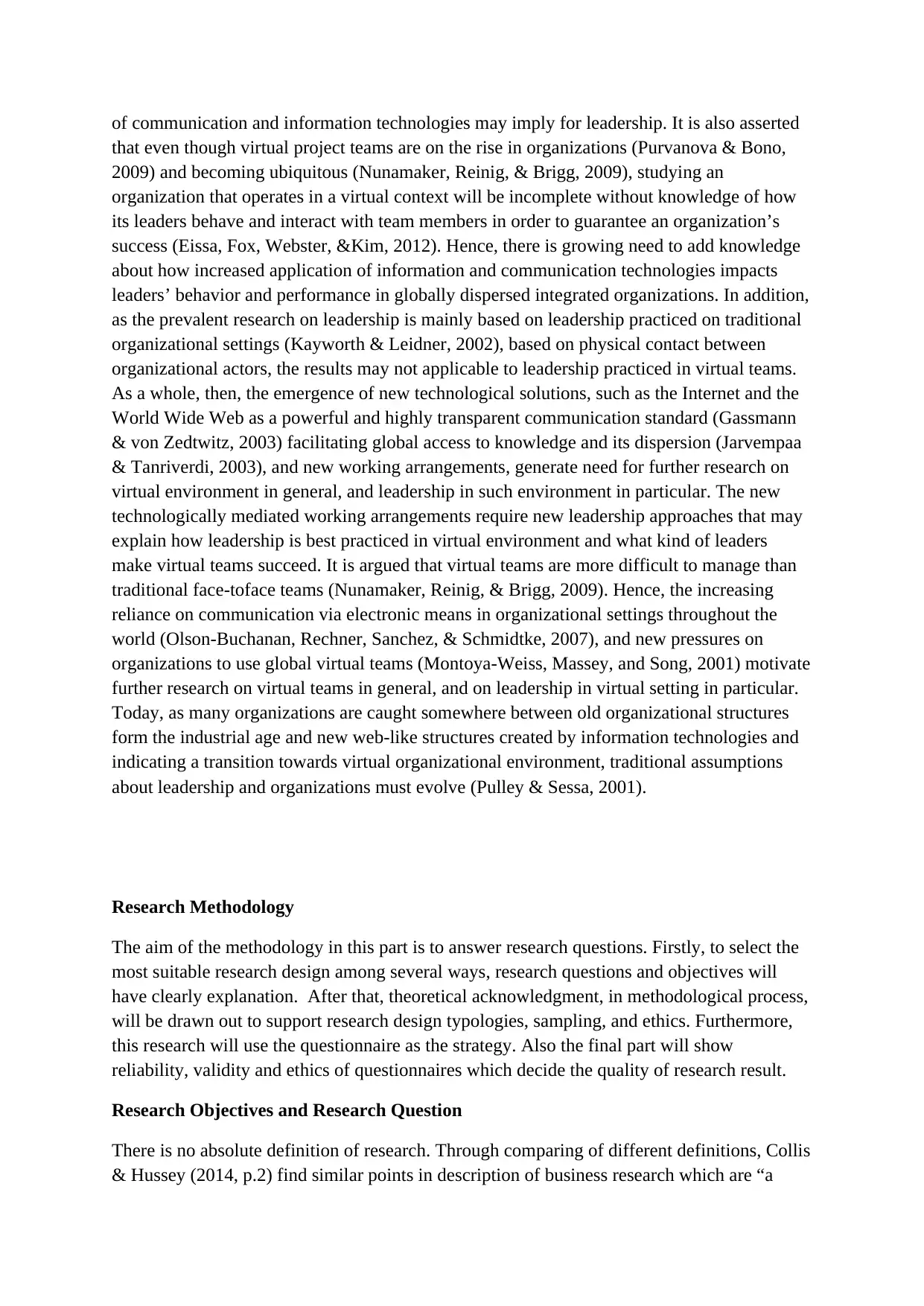
of communication and information technologies may imply for leadership. It is also asserted
that even though virtual project teams are on the rise in organizations (Purvanova & Bono,
2009) and becoming ubiquitous (Nunamaker, Reinig, & Brigg, 2009), studying an
organization that operates in a virtual context will be incomplete without knowledge of how
its leaders behave and interact with team members in order to guarantee an organization’s
success (Eissa, Fox, Webster, &Kim, 2012). Hence, there is growing need to add knowledge
about how increased application of information and communication technologies impacts
leaders’ behavior and performance in globally dispersed integrated organizations. In addition,
as the prevalent research on leadership is mainly based on leadership practiced on traditional
organizational settings (Kayworth & Leidner, 2002), based on physical contact between
organizational actors, the results may not applicable to leadership practiced in virtual teams.
As a whole, then, the emergence of new technological solutions, such as the Internet and the
World Wide Web as a powerful and highly transparent communication standard (Gassmann
& von Zedtwitz, 2003) facilitating global access to knowledge and its dispersion (Jarvempaa
& Tanriverdi, 2003), and new working arrangements, generate need for further research on
virtual environment in general, and leadership in such environment in particular. The new
technologically mediated working arrangements require new leadership approaches that may
explain how leadership is best practiced in virtual environment and what kind of leaders
make virtual teams succeed. It is argued that virtual teams are more difficult to manage than
traditional face-toface teams (Nunamaker, Reinig, & Brigg, 2009). Hence, the increasing
reliance on communication via electronic means in organizational settings throughout the
world (Olson-Buchanan, Rechner, Sanchez, & Schmidtke, 2007), and new pressures on
organizations to use global virtual teams (Montoya-Weiss, Massey, and Song, 2001) motivate
further research on virtual teams in general, and on leadership in virtual setting in particular.
Today, as many organizations are caught somewhere between old organizational structures
form the industrial age and new web-like structures created by information technologies and
indicating a transition towards virtual organizational environment, traditional assumptions
about leadership and organizations must evolve (Pulley & Sessa, 2001).
Research Methodology
The aim of the methodology in this part is to answer research questions. Firstly, to select the
most suitable research design among several ways, research questions and objectives will
have clearly explanation. After that, theoretical acknowledgment, in methodological process,
will be drawn out to support research design typologies, sampling, and ethics. Furthermore,
this research will use the questionnaire as the strategy. Also the final part will show
reliability, validity and ethics of questionnaires which decide the quality of research result.
Research Objectives and Research Question
There is no absolute definition of research. Through comparing of different definitions, Collis
& Hussey (2014, p.2) find similar points in description of business research which are “a
that even though virtual project teams are on the rise in organizations (Purvanova & Bono,
2009) and becoming ubiquitous (Nunamaker, Reinig, & Brigg, 2009), studying an
organization that operates in a virtual context will be incomplete without knowledge of how
its leaders behave and interact with team members in order to guarantee an organization’s
success (Eissa, Fox, Webster, &Kim, 2012). Hence, there is growing need to add knowledge
about how increased application of information and communication technologies impacts
leaders’ behavior and performance in globally dispersed integrated organizations. In addition,
as the prevalent research on leadership is mainly based on leadership practiced on traditional
organizational settings (Kayworth & Leidner, 2002), based on physical contact between
organizational actors, the results may not applicable to leadership practiced in virtual teams.
As a whole, then, the emergence of new technological solutions, such as the Internet and the
World Wide Web as a powerful and highly transparent communication standard (Gassmann
& von Zedtwitz, 2003) facilitating global access to knowledge and its dispersion (Jarvempaa
& Tanriverdi, 2003), and new working arrangements, generate need for further research on
virtual environment in general, and leadership in such environment in particular. The new
technologically mediated working arrangements require new leadership approaches that may
explain how leadership is best practiced in virtual environment and what kind of leaders
make virtual teams succeed. It is argued that virtual teams are more difficult to manage than
traditional face-toface teams (Nunamaker, Reinig, & Brigg, 2009). Hence, the increasing
reliance on communication via electronic means in organizational settings throughout the
world (Olson-Buchanan, Rechner, Sanchez, & Schmidtke, 2007), and new pressures on
organizations to use global virtual teams (Montoya-Weiss, Massey, and Song, 2001) motivate
further research on virtual teams in general, and on leadership in virtual setting in particular.
Today, as many organizations are caught somewhere between old organizational structures
form the industrial age and new web-like structures created by information technologies and
indicating a transition towards virtual organizational environment, traditional assumptions
about leadership and organizations must evolve (Pulley & Sessa, 2001).
Research Methodology
The aim of the methodology in this part is to answer research questions. Firstly, to select the
most suitable research design among several ways, research questions and objectives will
have clearly explanation. After that, theoretical acknowledgment, in methodological process,
will be drawn out to support research design typologies, sampling, and ethics. Furthermore,
this research will use the questionnaire as the strategy. Also the final part will show
reliability, validity and ethics of questionnaires which decide the quality of research result.
Research Objectives and Research Question
There is no absolute definition of research. Through comparing of different definitions, Collis
& Hussey (2014, p.2) find similar points in description of business research which are “a
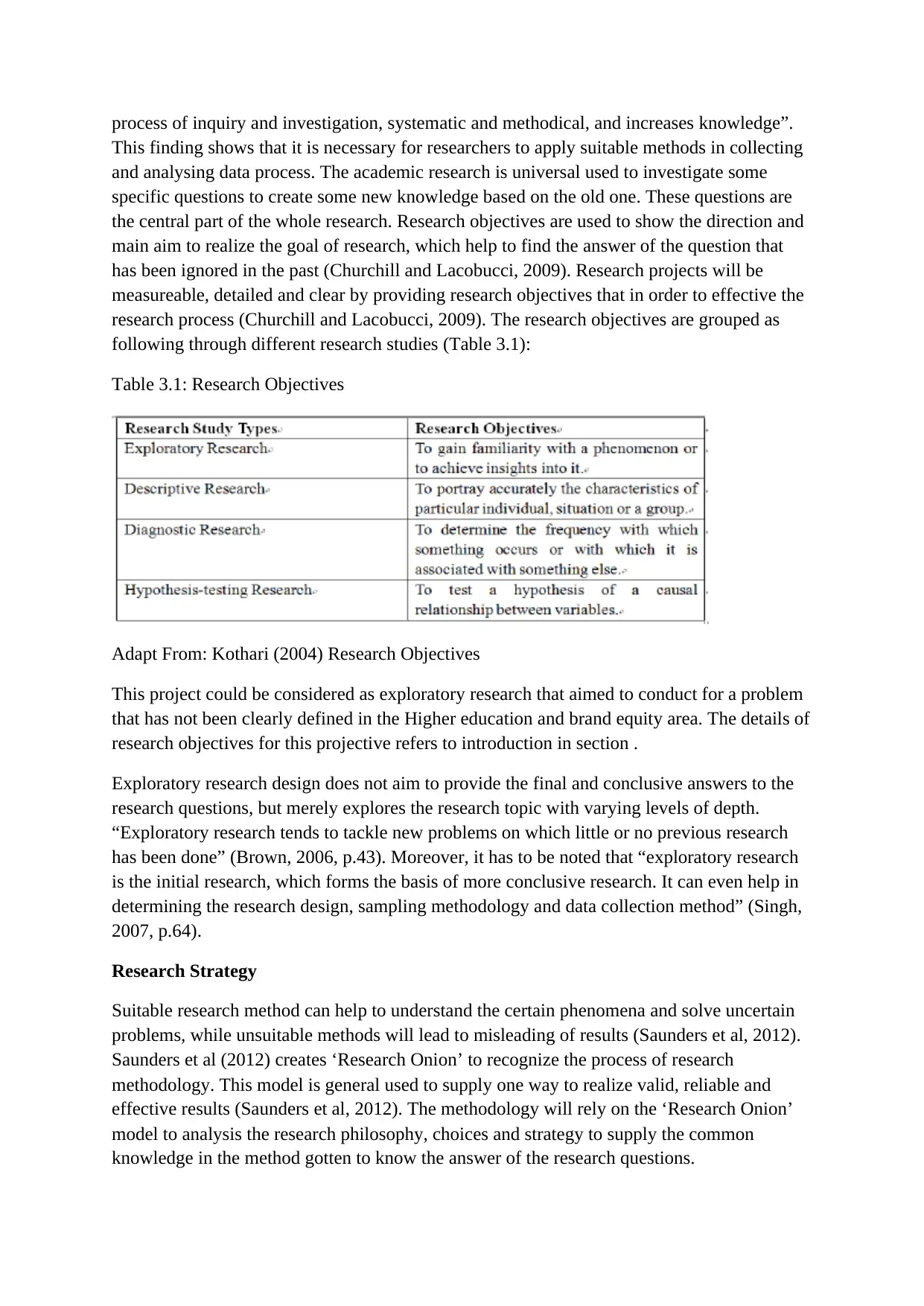
process of inquiry and investigation, systematic and methodical, and increases knowledge”.
This finding shows that it is necessary for researchers to apply suitable methods in collecting
and analysing data process. The academic research is universal used to investigate some
specific questions to create some new knowledge based on the old one. These questions are
the central part of the whole research. Research objectives are used to show the direction and
main aim to realize the goal of research, which help to find the answer of the question that
has been ignored in the past (Churchill and Lacobucci, 2009). Research projects will be
measureable, detailed and clear by providing research objectives that in order to effective the
research process (Churchill and Lacobucci, 2009). The research objectives are grouped as
following through different research studies (Table 3.1):
Table 3.1: Research Objectives
Adapt From: Kothari (2004) Research Objectives
This project could be considered as exploratory research that aimed to conduct for a problem
that has not been clearly defined in the Higher education and brand equity area. The details of
research objectives for this projective refers to introduction in section .
Exploratory research design does not aim to provide the final and conclusive answers to the
research questions, but merely explores the research topic with varying levels of depth.
“Exploratory research tends to tackle new problems on which little or no previous research
has been done” (Brown, 2006, p.43). Moreover, it has to be noted that “exploratory research
is the initial research, which forms the basis of more conclusive research. It can even help in
determining the research design, sampling methodology and data collection method” (Singh,
2007, p.64).
Research Strategy
Suitable research method can help to understand the certain phenomena and solve uncertain
problems, while unsuitable methods will lead to misleading of results (Saunders et al, 2012).
Saunders et al (2012) creates ‘Research Onion’ to recognize the process of research
methodology. This model is general used to supply one way to realize valid, reliable and
effective results (Saunders et al, 2012). The methodology will rely on the ‘Research Onion’
model to analysis the research philosophy, choices and strategy to supply the common
knowledge in the method gotten to know the answer of the research questions.
This finding shows that it is necessary for researchers to apply suitable methods in collecting
and analysing data process. The academic research is universal used to investigate some
specific questions to create some new knowledge based on the old one. These questions are
the central part of the whole research. Research objectives are used to show the direction and
main aim to realize the goal of research, which help to find the answer of the question that
has been ignored in the past (Churchill and Lacobucci, 2009). Research projects will be
measureable, detailed and clear by providing research objectives that in order to effective the
research process (Churchill and Lacobucci, 2009). The research objectives are grouped as
following through different research studies (Table 3.1):
Table 3.1: Research Objectives
Adapt From: Kothari (2004) Research Objectives
This project could be considered as exploratory research that aimed to conduct for a problem
that has not been clearly defined in the Higher education and brand equity area. The details of
research objectives for this projective refers to introduction in section .
Exploratory research design does not aim to provide the final and conclusive answers to the
research questions, but merely explores the research topic with varying levels of depth.
“Exploratory research tends to tackle new problems on which little or no previous research
has been done” (Brown, 2006, p.43). Moreover, it has to be noted that “exploratory research
is the initial research, which forms the basis of more conclusive research. It can even help in
determining the research design, sampling methodology and data collection method” (Singh,
2007, p.64).
Research Strategy
Suitable research method can help to understand the certain phenomena and solve uncertain
problems, while unsuitable methods will lead to misleading of results (Saunders et al, 2012).
Saunders et al (2012) creates ‘Research Onion’ to recognize the process of research
methodology. This model is general used to supply one way to realize valid, reliable and
effective results (Saunders et al, 2012). The methodology will rely on the ‘Research Onion’
model to analysis the research philosophy, choices and strategy to supply the common
knowledge in the method gotten to know the answer of the research questions.
⊘ This is a preview!⊘
Do you want full access?
Subscribe today to unlock all pages.

Trusted by 1+ million students worldwide
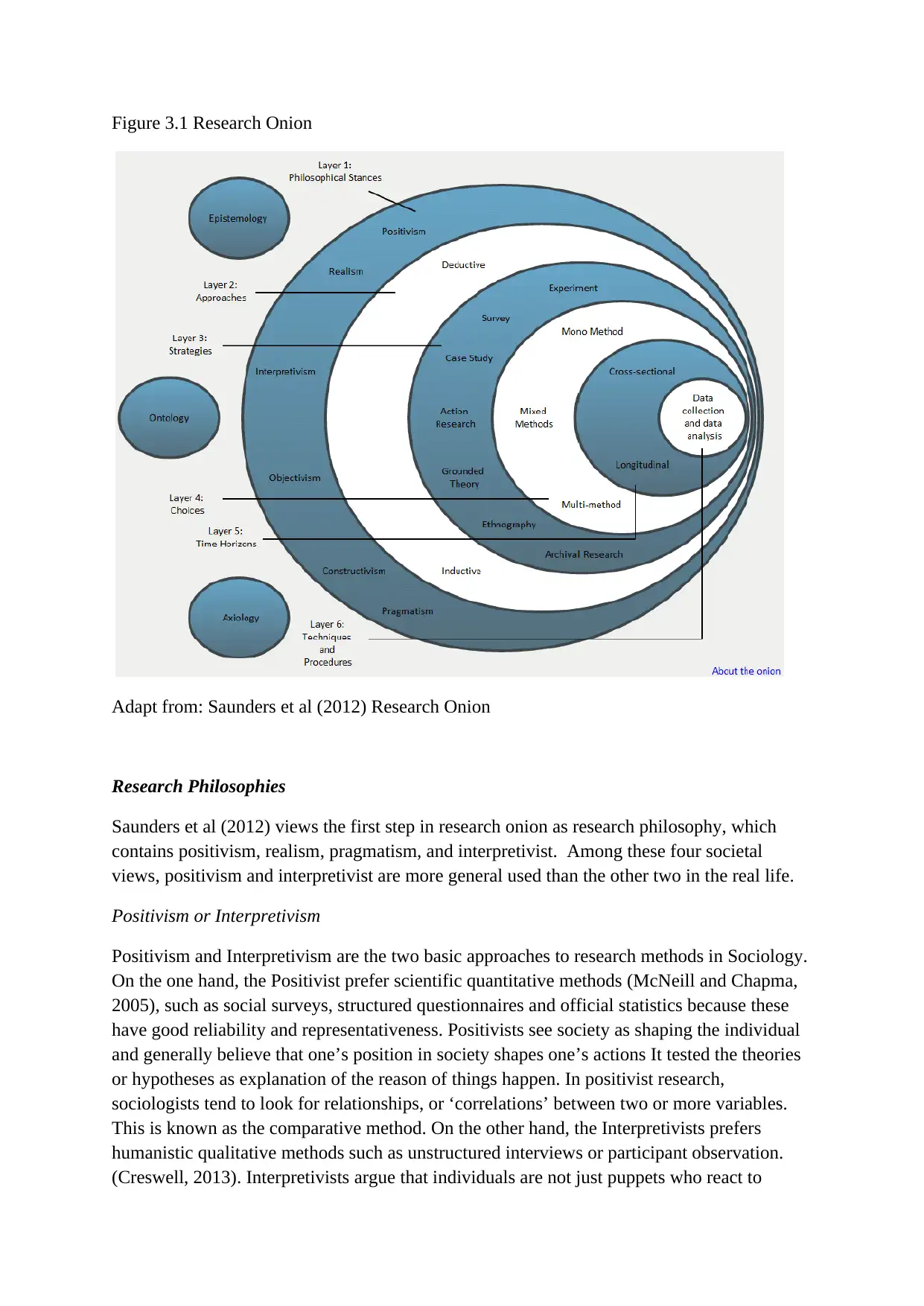
Figure 3.1 Research Onion
Adapt from: Saunders et al (2012) Research Onion
Research Philosophies
Saunders et al (2012) views the first step in research onion as research philosophy, which
contains positivism, realism, pragmatism, and interpretivist. Among these four societal
views, positivism and interpretivist are more general used than the other two in the real life.
Positivism or Interpretivism
Positivism and Interpretivism are the two basic approaches to research methods in Sociology.
On the one hand, the Positivist prefer scientific quantitative methods (McNeill and Chapma,
2005), such as social surveys, structured questionnaires and official statistics because these
have good reliability and representativeness. Positivists see society as shaping the individual
and generally believe that one’s position in society shapes one’s actions It tested the theories
or hypotheses as explanation of the reason of things happen. In positivist research,
sociologists tend to look for relationships, or ‘correlations’ between two or more variables.
This is known as the comparative method. On the other hand, the Interpretivists prefers
humanistic qualitative methods such as unstructured interviews or participant observation.
(Creswell, 2013). Interpretivists argue that individuals are not just puppets who react to
Adapt from: Saunders et al (2012) Research Onion
Research Philosophies
Saunders et al (2012) views the first step in research onion as research philosophy, which
contains positivism, realism, pragmatism, and interpretivist. Among these four societal
views, positivism and interpretivist are more general used than the other two in the real life.
Positivism or Interpretivism
Positivism and Interpretivism are the two basic approaches to research methods in Sociology.
On the one hand, the Positivist prefer scientific quantitative methods (McNeill and Chapma,
2005), such as social surveys, structured questionnaires and official statistics because these
have good reliability and representativeness. Positivists see society as shaping the individual
and generally believe that one’s position in society shapes one’s actions It tested the theories
or hypotheses as explanation of the reason of things happen. In positivist research,
sociologists tend to look for relationships, or ‘correlations’ between two or more variables.
This is known as the comparative method. On the other hand, the Interpretivists prefers
humanistic qualitative methods such as unstructured interviews or participant observation.
(Creswell, 2013). Interpretivists argue that individuals are not just puppets who react to
Paraphrase This Document
Need a fresh take? Get an instant paraphrase of this document with our AI Paraphraser
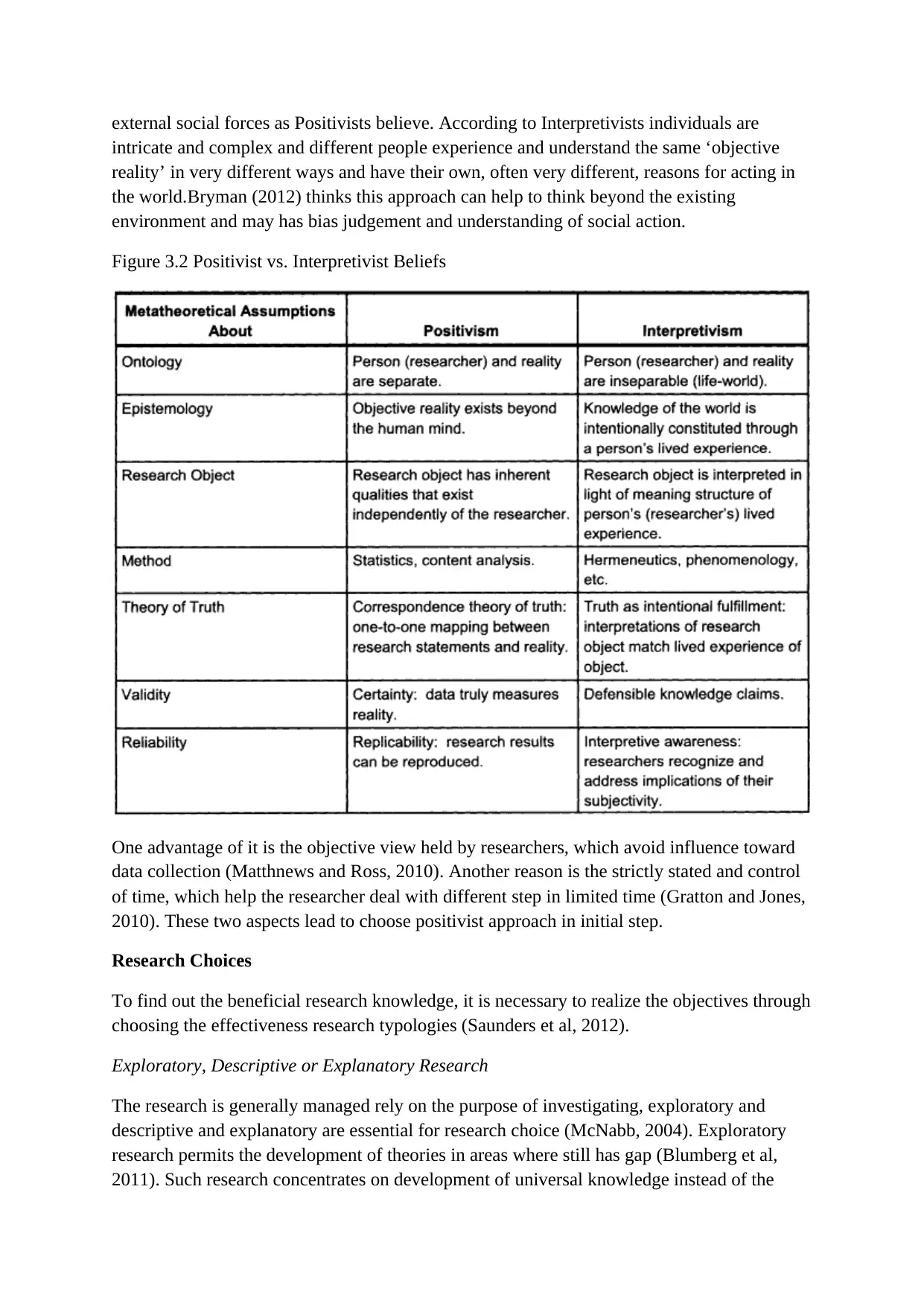
external social forces as Positivists believe. According to Interpretivists individuals are
intricate and complex and different people experience and understand the same ‘objective
reality’ in very different ways and have their own, often very different, reasons for acting in
the world.Bryman (2012) thinks this approach can help to think beyond the existing
environment and may has bias judgement and understanding of social action.
Figure 3.2 Positivist vs. Interpretivist Beliefs
One advantage of it is the objective view held by researchers, which avoid influence toward
data collection (Matthnews and Ross, 2010). Another reason is the strictly stated and control
of time, which help the researcher deal with different step in limited time (Gratton and Jones,
2010). These two aspects lead to choose positivist approach in initial step.
Research Choices
To find out the beneficial research knowledge, it is necessary to realize the objectives through
choosing the effectiveness research typologies (Saunders et al, 2012).
Exploratory, Descriptive or Explanatory Research
The research is generally managed rely on the purpose of investigating, exploratory and
descriptive and explanatory are essential for research choice (McNabb, 2004). Exploratory
research permits the development of theories in areas where still has gap (Blumberg et al,
2011). Such research concentrates on development of universal knowledge instead of the
intricate and complex and different people experience and understand the same ‘objective
reality’ in very different ways and have their own, often very different, reasons for acting in
the world.Bryman (2012) thinks this approach can help to think beyond the existing
environment and may has bias judgement and understanding of social action.
Figure 3.2 Positivist vs. Interpretivist Beliefs
One advantage of it is the objective view held by researchers, which avoid influence toward
data collection (Matthnews and Ross, 2010). Another reason is the strictly stated and control
of time, which help the researcher deal with different step in limited time (Gratton and Jones,
2010). These two aspects lead to choose positivist approach in initial step.
Research Choices
To find out the beneficial research knowledge, it is necessary to realize the objectives through
choosing the effectiveness research typologies (Saunders et al, 2012).
Exploratory, Descriptive or Explanatory Research
The research is generally managed rely on the purpose of investigating, exploratory and
descriptive and explanatory are essential for research choice (McNabb, 2004). Exploratory
research permits the development of theories in areas where still has gap (Blumberg et al,
2011). Such research concentrates on development of universal knowledge instead of the
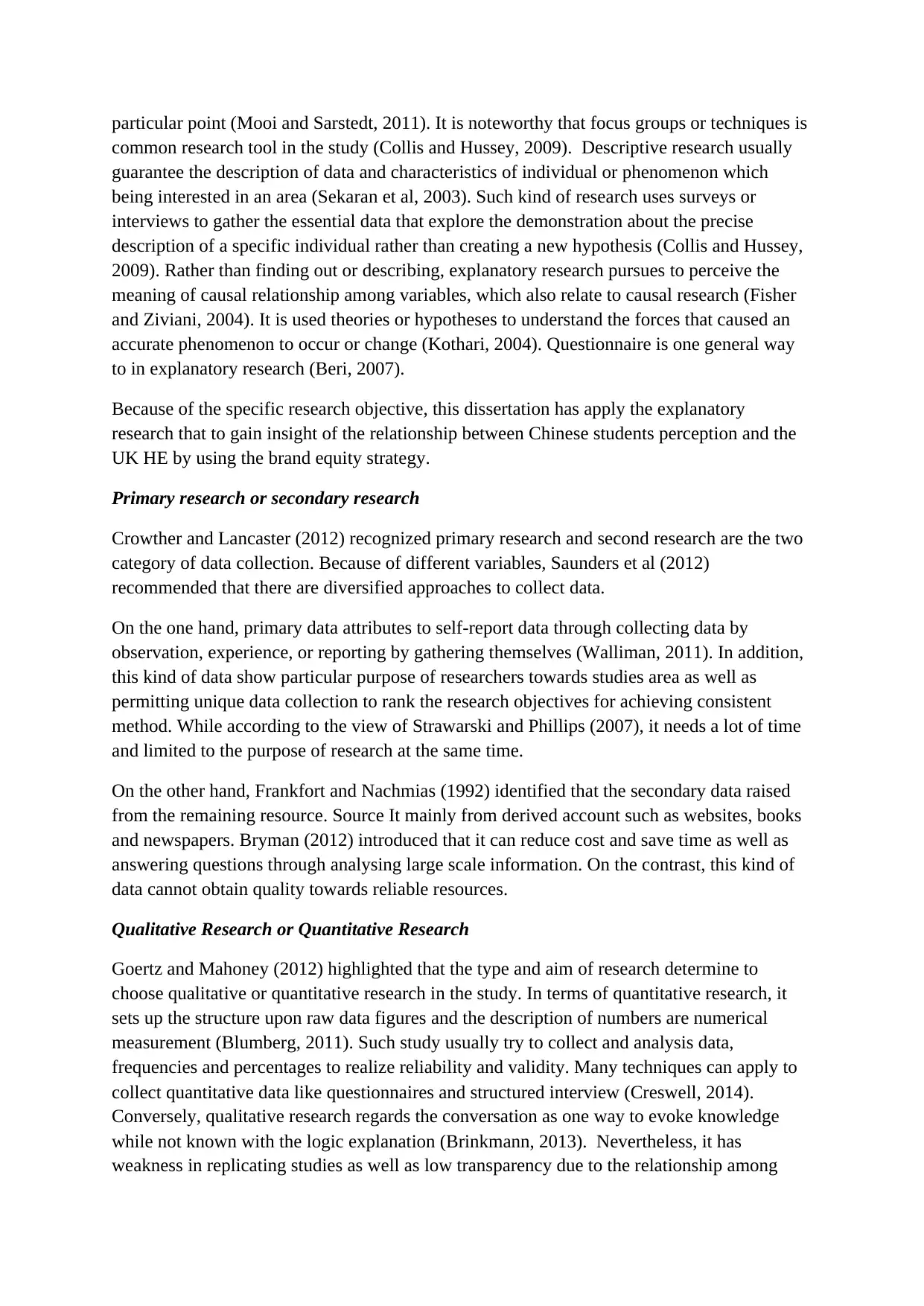
particular point (Mooi and Sarstedt, 2011). It is noteworthy that focus groups or techniques is
common research tool in the study (Collis and Hussey, 2009). Descriptive research usually
guarantee the description of data and characteristics of individual or phenomenon which
being interested in an area (Sekaran et al, 2003). Such kind of research uses surveys or
interviews to gather the essential data that explore the demonstration about the precise
description of a specific individual rather than creating a new hypothesis (Collis and Hussey,
2009). Rather than finding out or describing, explanatory research pursues to perceive the
meaning of causal relationship among variables, which also relate to causal research (Fisher
and Ziviani, 2004). It is used theories or hypotheses to understand the forces that caused an
accurate phenomenon to occur or change (Kothari, 2004). Questionnaire is one general way
to in explanatory research (Beri, 2007).
Because of the specific research objective, this dissertation has apply the explanatory
research that to gain insight of the relationship between Chinese students perception and the
UK HE by using the brand equity strategy.
Primary research or secondary research
Crowther and Lancaster (2012) recognized primary research and second research are the two
category of data collection. Because of different variables, Saunders et al (2012)
recommended that there are diversified approaches to collect data.
On the one hand, primary data attributes to self-report data through collecting data by
observation, experience, or reporting by gathering themselves (Walliman, 2011). In addition,
this kind of data show particular purpose of researchers towards studies area as well as
permitting unique data collection to rank the research objectives for achieving consistent
method. While according to the view of Strawarski and Phillips (2007), it needs a lot of time
and limited to the purpose of research at the same time.
On the other hand, Frankfort and Nachmias (1992) identified that the secondary data raised
from the remaining resource. Source It mainly from derived account such as websites, books
and newspapers. Bryman (2012) introduced that it can reduce cost and save time as well as
answering questions through analysing large scale information. On the contrast, this kind of
data cannot obtain quality towards reliable resources.
Qualitative Research or Quantitative Research
Goertz and Mahoney (2012) highlighted that the type and aim of research determine to
choose qualitative or quantitative research in the study. In terms of quantitative research, it
sets up the structure upon raw data figures and the description of numbers are numerical
measurement (Blumberg, 2011). Such study usually try to collect and analysis data,
frequencies and percentages to realize reliability and validity. Many techniques can apply to
collect quantitative data like questionnaires and structured interview (Creswell, 2014).
Conversely, qualitative research regards the conversation as one way to evoke knowledge
while not known with the logic explanation (Brinkmann, 2013). Nevertheless, it has
weakness in replicating studies as well as low transparency due to the relationship among
common research tool in the study (Collis and Hussey, 2009). Descriptive research usually
guarantee the description of data and characteristics of individual or phenomenon which
being interested in an area (Sekaran et al, 2003). Such kind of research uses surveys or
interviews to gather the essential data that explore the demonstration about the precise
description of a specific individual rather than creating a new hypothesis (Collis and Hussey,
2009). Rather than finding out or describing, explanatory research pursues to perceive the
meaning of causal relationship among variables, which also relate to causal research (Fisher
and Ziviani, 2004). It is used theories or hypotheses to understand the forces that caused an
accurate phenomenon to occur or change (Kothari, 2004). Questionnaire is one general way
to in explanatory research (Beri, 2007).
Because of the specific research objective, this dissertation has apply the explanatory
research that to gain insight of the relationship between Chinese students perception and the
UK HE by using the brand equity strategy.
Primary research or secondary research
Crowther and Lancaster (2012) recognized primary research and second research are the two
category of data collection. Because of different variables, Saunders et al (2012)
recommended that there are diversified approaches to collect data.
On the one hand, primary data attributes to self-report data through collecting data by
observation, experience, or reporting by gathering themselves (Walliman, 2011). In addition,
this kind of data show particular purpose of researchers towards studies area as well as
permitting unique data collection to rank the research objectives for achieving consistent
method. While according to the view of Strawarski and Phillips (2007), it needs a lot of time
and limited to the purpose of research at the same time.
On the other hand, Frankfort and Nachmias (1992) identified that the secondary data raised
from the remaining resource. Source It mainly from derived account such as websites, books
and newspapers. Bryman (2012) introduced that it can reduce cost and save time as well as
answering questions through analysing large scale information. On the contrast, this kind of
data cannot obtain quality towards reliable resources.
Qualitative Research or Quantitative Research
Goertz and Mahoney (2012) highlighted that the type and aim of research determine to
choose qualitative or quantitative research in the study. In terms of quantitative research, it
sets up the structure upon raw data figures and the description of numbers are numerical
measurement (Blumberg, 2011). Such study usually try to collect and analysis data,
frequencies and percentages to realize reliability and validity. Many techniques can apply to
collect quantitative data like questionnaires and structured interview (Creswell, 2014).
Conversely, qualitative research regards the conversation as one way to evoke knowledge
while not known with the logic explanation (Brinkmann, 2013). Nevertheless, it has
weakness in replicating studies as well as low transparency due to the relationship among
⊘ This is a preview!⊘
Do you want full access?
Subscribe today to unlock all pages.

Trusted by 1+ million students worldwide
1 out of 24
Related Documents
Your All-in-One AI-Powered Toolkit for Academic Success.
+13062052269
info@desklib.com
Available 24*7 on WhatsApp / Email
![[object Object]](/_next/static/media/star-bottom.7253800d.svg)
Unlock your academic potential
Copyright © 2020–2025 A2Z Services. All Rights Reserved. Developed and managed by ZUCOL.




